M 22
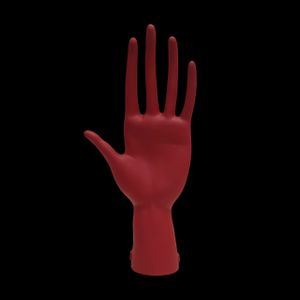
Elica Studio > Styling
M 22 Material Porcelain, engobes Finishing Matte Sizes (cm) 17837 Weight (g) 1020 Designed in 2022 Collection Anatomika Lead Time: 30 days What Makes the M 22 Special The M 22 is a real eye-catcher. It’s not just a vase or a bowl—it’s a sculpture that adds something special to any room. Made from high-quality porcelain, it’s both strong and elegant. The use of engobes gives it a unique texture and look, with subtle color changes that catch the light in interesting ways. Depending on the model, the M 22 can have a smooth, shiny finish or a soft, matte look. Both are stylish, but they give off different vibes. The glossy version is bold and modern, while the matte one feels more understated and natural. The Look and Feel The M 22 is inspired by organic shapes—think curves and flowing lines that remind you of something alive. Its form is simple but striking, making it a great centerpiece for any table, shelf, or display. Whether you put it in a living room, a boutique hotel, or a stylish shop, it’s sure to get people talking. Because it’s made from porcelain, the M 22 feels solid and well-made. It’s not too heavy to move around, but it’s got enough presence to stand out. The exact size and weight are listed on the product page, so you can check if it fits your space. How to Style the M 22 One of the best things about the M 22 is how easy it is to work with. Its neutral colors and clean lines mean it fits in with almost any style. If your space is minimalist, the M 22 adds a touch of art without being too much. If your style is more eclectic, it blends right in and gives you a cool focal point. Try pairing it with metallic accents, like gold or silver trays, or with textured fabrics and bold art. It looks great on its own, but it also plays well with other pieces. If you’re styling a photo shoot or a display, the M 22 is a great choice—it’s interesting from every angle. Made to Order, Ready for You Every M 22 is made just for you. That means you get a piece that’s crafted with care and attention to detail. The lead time is always 30 days, so you can plan ahead and know exactly when your order will arrive. This is perfect for designers who need to stick to a schedule. Who Should Get the M 22? If you’re an interior designer or stylist looking for something unique, the M 22 is a great pick. It’s not just another vase—it’s a sculpture that brings art into everyday spaces. It works in homes, offices, hotels, and shops. Wherever you put it, it adds a modern, artistic touch. Why Choose the M 22? It’s simple: the M 22 is beautiful, well-made, and easy to style. It’s not fussy or hard to work with. It’s just a great piece that makes any space look better. Whether you want to make a statement or just add a little something special, the M 22 is a smart choice.
BIG EYE
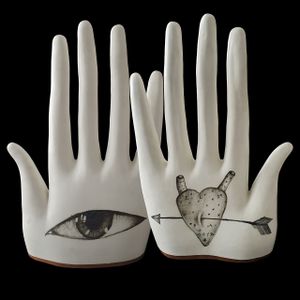
Elica Studio > Styling
BIG EYE Material Porcelain, glaze, oxides Finishing Matte Sizes (cm) 27 X 10 X 41 Weight (g) 2150 Designed in 2019 Collection Anatomika Lead Time: 30 days What Makes Mano Grande Con Occhio (BIG EYE) Special Mano Grande Con Occhio—or BIG EYE, as it’s affectionately known—is a real showstopper. This isn’t just another decorative piece; it’s a sculpture that grabs attention and sparks conversation. Inspired by the human body, BIG EYE features a large hand with a bold, open eye in the palm. It’s modern, expressive, and full of personality, making it a favorite for designers and stylists who want to make a statement. Materials and Craftsmanship BIG EYE is made from high-quality porcelain, known for its smooth, strong, and timeless look. The use of engobes—a special clay slip—adds texture and subtle color changes, making the surface interesting to look at and touch. Depending on the model, BIG EYE can have a soft matte finish or a shiny, glossy look. Both options are stylish, but they create different moods. The matte finish feels calm and natural, while the glossy one is bold and eye-catching. The Design: Hand and Eye The design of BIG EYE is all about expression and connection. The large hand is open and welcoming, with a striking eye in the palm. This eye adds a sense of mystery and depth, making the piece feel alive and engaging. The lines are smooth and flowing, so it looks good from every angle. With dimensions of 38 × 19 × 15 cm and a weight of 2,800 grams, BIG EYE is substantial enough to be a real centerpiece, but not so heavy that it’s hard to move. How to Use BIG EYE in Your Space BIG EYE is super versatile. Its neutral colors and expressive design mean it fits in with almost any style. If your space is modern and minimal, BIG EYE adds a touch of drama without being too much. If your style is more eclectic or artistic, it blends in nicely and gives you a focal point that’s full of personality. Try pairing BIG EYE with other natural materials, like wood or stone, for a relaxed, earthy look. Or, mix it with metallic accents for a more glamorous vibe. It also works well in photo shoots and displays, where its unique shape and expressive eye can really shine. Because of its size—38 × 19 × 15 cm—BIG EYE is perfect for placing on a console table, a sideboard, or as a centerpiece on a large dining table. Its weight—2,800 grams—means it’s solid and stable, so it won’t tip over easily. Made to Order, Always Ready in 30 Days Every BIG EYE is made just for you. That means each piece is crafted with care and attention to detail. The lead time is always 30 days, so you can plan your projects and know exactly when your order will arrive. This is perfect for designers and stylists who need to stick to a schedule. Who Should Get BIG EYE? If you want to add a bit of drama and personality to your interiors, BIG EYE is a great pick. It’s not just a decoration—it’s a statement about expression, connection, and creativity. It works in homes, offices, hotels, and shops. Wherever you put it, it adds a modern, artistic touch. Why Choose BIG EYE? In short, it’s beautiful, well-made, and easy to style. It’s not fussy or hard to work with. It’s just a great piece that makes any space feel more lively and interesting. Whether you want to make a statement or just add a little something special, BIG EYE is a smart choice. Wrapping Up Mano Grande Con Occhio (BIG EYE) by Elica Design Studio is a standout piece for anyone who loves modern design with a twist. It’s made from top-quality materials, looks amazing, and fits in with all kinds of styles. With its generous size (38 × 19 × 15 cm) and solid weight (2,800 grams), it’s a real presence in any room. For the exact year it was designed, check the product page. With a 30-day lead time, you can count on it to be ready when you need it.
DPM 22 RET
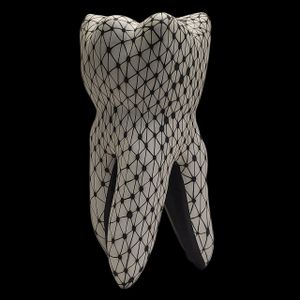
Elica Studio > Styling
DPM 22 RET Material Porcelain, glaze, oxides Finishing Matte Sizes (cm) 16 X16 X 36 Weight (g) 1200 Designed in 2022 Collection Anatomika Lead Time: 30 days DPM22 RET is a sculptural porcelain piece shaped like an oversized human molar—an object both instantly recognisable and transformed through artistic reinterpretation. The anatomy is faithful yet stylised, and the surface is enveloped in a meticulously hand-painted black mesh pattern that flows organically across every curve. The grid-like motif consists of intersecting black lines and nodes, giving the surface a sense of rhythm and movement. The pattern interacts with the form—stretching across ridges, dipping into recesses—creating visual tension that enhances the dimensionality of the piece. Despite the strong geometric structure, the result is soft, almost organic in its optical effect. The matte white porcelain base absorbs light gently, allowing the black pattern to remain crisp and tactile. The interior of the roots is deepened with a darker tone, creating visual contrast and suggesting depth beyond the surface. Styling & Placement Suggestions Contemporary Interiors: Use DPM22 RET as a sculptural object on a floating shelf or plinth. Its graphic presence adds a sense of boldness and wit to minimalist spaces. Artistic or Conceptual Spaces: Place under soft spotlighting to highlight the interplay of form and pattern. Perfect for gallery walls, design studios, or cultural venues. Eclectic Rooms: Combine with organic ceramics, stone textures, or surrealist-inspired objects to build a dialogue of contrast and symbolism. Retail & Hospitality Settings: In hotel lobbies or boutique counters, it offers a conversation-starting sculptural element with visual clarity and artistic integrity. Why Interior Designers Choose DPM22 RET Unexpected Form: The anatomical tooth is transformed into a stylised artefact—balancing familiarity with abstraction. Surface Complexity: The hand-painted net pattern introduces visual rhythm while wrapping three-dimensional curves in a graphic skin. Tactile Contrast: Matte white and dark lines create a clean yet intense surface dynamic.
Compatta Limo
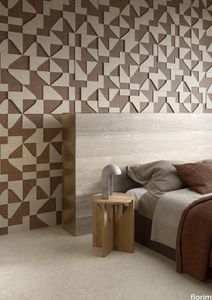
florim > Wall tile-stone-brick
<p>A passion for earth as a natural material and for rammed earth, an ancient construction technique.</p> <p>The combination of these patterns evolves into the concept of Pisé Inserti, more slabs of immense decorative impact, generated by the two-dimensional criss-crossing of exquisite, rounded geometrical forms: the designer combines the natural earthen shades with apparently random curved lines that evoke the uneven trapezia with rounded corners used by Gio Ponti.</p> <p>These are also available in the large 120x280 cm size and 6 mm thickness in three variants: Pisé Inserti A, Pisé Inserti B and Pisé Inserti C. COMPATTA’s potential is further enhanced by three-dimensional subjects of varying shapes, which can be built up into mesh-backed mosaics to create sculptural forms on walls. These extensions to the collection are called Inserti Melange, Inserti Sabbia-Argilla and Inserti Limo-Ghiaia and are produced in 9 mm thickness and 30x30 cm size.</p> <p>The collection is born from a sustainable and virtuous approach and is part of <a href="https://www.florim.com/en/company/sustainability/carbonzero-florim/">CarbonZero</a>, Florim's range of Carbon Neutral surfaces.</p> <p>The COMPATTA collection, designed by Federico Peri, combines a passion for earth as a natural material and an interest in a very ancient construction technique.<br>The primary inspiration derives from close observation of the many strata within the ground and the mixtures of elementary particles of which it consists. The design concept is completed by reference to the age-old rammed earth construction technique, used in northern Jordan since the eighth millennium BCE and widely applied in Yemen in many other desert or rural settings until the mid 19thC.<br>In this method, the raw earth is compacted inside wooden formwork to construct continuous structural walls, bearing walls or partitions inside homes, with a natural decorative effect due to the layering of the different shades of clay used. When creating his project for CEDIT, Peri was also influenced by several design inputs: from rural African homes to the clear, simple geometric forms and curved lines typical of the work of Gio Ponti, the curves central to the modernist gardens of Brazilian landscape artist Roberto Burle Marx, and the three-dimensional mosaics of English sculptor William Mitchell. In his murals in concrete, glass and recycled materials, Mitchell seems to combine some of the typical features of a variety of artistic movements, from Modernism to Brutalism, and also shows awareness of the issues concerning the structure of the landscape and the relationship with nature at the heart of Land Art. COMPATTA thus embodies strong links to the world of art and architecture, while bringing natural impressions with a remote, primitive flavour into modern living-spaces.</p>
Compatta Pisé Melange

florim > Wall tile-stone-brick
<p>A passion for earth as a natural material and for rammed earth, an ancient construction technique.</p> <p>The combination of these patterns evolves into the concept of Pisé Inserti, more slabs of immense decorative impact, generated by the two-dimensional criss-crossing of exquisite, rounded geometrical forms: the designer combines the natural earthen shades with apparently random curved lines that evoke the uneven trapezia with rounded corners used by Gio Ponti.</p> <p>These are also available in the large 120x280 cm size and 6 mm thickness in three variants: Pisé Inserti A, Pisé Inserti B and Pisé Inserti C. COMPATTA’s potential is further enhanced by three-dimensional subjects of varying shapes, which can be built up into mesh-backed mosaics to create sculptural forms on walls. These extensions to the collection are called Inserti Melange, Inserti Sabbia-Argilla and Inserti Limo-Ghiaia and are produced in 9 mm thickness and 30x30 cm size.</p> <p>The collection is born from a sustainable and virtuous approach and is part of <a href="https://www.florim.com/en/company/sustainability/carbonzero-florim/">CarbonZero</a>, Florim's range of Carbon Neutral surfaces.</p> <p>The COMPATTA collection, designed by Federico Peri, combines a passion for earth as a natural material and an interest in a very ancient construction technique.<br>The primary inspiration derives from close observation of the many strata within the ground and the mixtures of elementary particles of which it consists. The design concept is completed by reference to the age-old rammed earth construction technique, used in northern Jordan since the eighth millennium BCE and widely applied in Yemen in many other desert or rural settings until the mid 19thC.<br>In this method, the raw earth is compacted inside wooden formwork to construct continuous structural walls, bearing walls or partitions inside homes, with a natural decorative effect due to the layering of the different shades of clay used. When creating his project for CEDIT, Peri was also influenced by several design inputs: from rural African homes to the clear, simple geometric forms and curved lines typical of the work of Gio Ponti, the curves central to the modernist gardens of Brazilian landscape artist Roberto Burle Marx, and the three-dimensional mosaics of English sculptor William Mitchell. In his murals in concrete, glass and recycled materials, Mitchell seems to combine some of the typical features of a variety of artistic movements, from Modernism to Brutalism, and also shows awareness of the issues concerning the structure of the landscape and the relationship with nature at the heart of Land Art. COMPATTA thus embodies strong links to the world of art and architecture, while bringing natural impressions with a remote, primitive flavour into modern living-spaces.</p>
Oltremare Poltrona
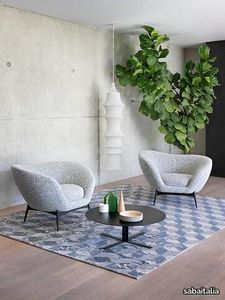
sabaitalia > Armchair
The seating collection “Oltremare” designed by Antonio Marras and produced in collaboration with Saba, stems from a far-away past and place, full of history, recollection, memories overflowing with suggestions and visions. And this is how Antonio Marras presented an object so dear to him that he defines a sacred-idol, that narrates of his land, of his sea, but mostly, of his story. We named it Oltremare, because all things have a soul and every soul has a name. Oltremare encloses within its inlets the classic and the modern. The curve is a line that can be tamed: it forms a wave, a fold, it creates a place but it also offers an escape route. In our utopian world we investigated the relationship between the curved line and the act of seating, asymmetric shapes that become backrests and sink into extremely comfortable seats pushing past the rectangular schemes so dear to the sober lines of designing sofas. The asymmetric curves that enclose it are the inspirations for the Oltremare armchair that completes the collection alongside a padded bench. A comfortable nest suspended on a slim varnished metal base, whose essential lines render, by contract, the armchair’s silhouette even more interesting. Oltremare is a seating system that, even though winks at the past, it communicates a strong contemporary soul and is suitable by nature to various interpretations. Fully removable covers.
Tide Duvet Cover
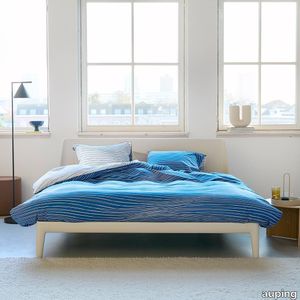
auping > Accessories
A cotton satin duvet cover with a hypnotic wave pattern like a calmly rippling lake. One side of the duvet cover is bright blue in colour with an irregular pattern of soft white lines, while the other side is a warm white with fresh blue lines. This duvet cover gives you two designs to choose from, ... Extra long tuck-in strip All Auping duvet covers have an extra long tuck-in strip across the entire width and on both sides. This makes it easy to tuck the duvet cover under your mattress. Cold feet are a thing of the past. You can recognize the extra long tuck-in strip by the length: 200/220. Pillowcase with double hotel closure The Auping pillowcases from the seasonal collection have a so-called double hotel closure. A hotel closure is a folded opening on the shortest side of the pillowcase. With a double hotel closure, it doesn't matter which side of your pillow you use, it always looks neat. Button down Auping duvet covers and duvets feature the button down system. These are convenient buttons and loops that you use to fasten the duvet and cover together so it won't shift. The term button down comes from fashion. It literally means "buttoned down" and often refers to the buttons on the collar of a shirt that you use to neatly fasten the collar to the shirt. Auping duvet covers have loops on the inside of the cover. Our duvets have buttons in the same places. The loops from the duvet cover can be put around these buttons so the duvet can't move around in the cover. And with these buttons and loops it is also easier to make your bed neatly. Sustainable sleeping At Auping, we dream of a rested world. Of sleeping under wonderful bedding that is made in an environmentally friendly way and under good working conditions. The covers in our spring 2023 collection carry the OEKO-TEX label as well as the BCI label, which also guarantees bedding produced in a sustainable and socially responsible manner.
Charcoal Duvet Cover
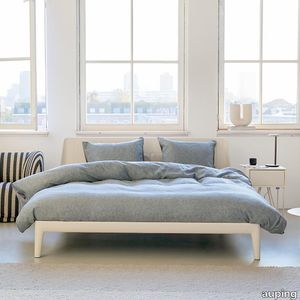
auping > Accessories
A timeless duvet cover with a (luxurious) mix of linen and cotton, giving it a deliciously soft feel. It is woven from black and white yarns which combine to create a refreshing shade of grey. The rear side of the duvet is made of cotton satin in a beautiful shade of anthracite. The linen mix is 55%... Extra long tuck-in strip All Auping duvet covers have an extra long tuck-in strip across the entire width and on both sides. This makes it easy to tuck the duvet cover under your mattress. Cold feet are a thing of the past. You can recognize the extra long tuck-in strip by the length: 200/220. Pillowcase with double hotel closure The Auping pillowcases from the seasonal collection have a so-called double hotel closure. A hotel closure is a folded opening on the shortest side of the pillowcase. With a double hotel closure, it doesn't matter which side of your pillow you use, it always looks neat. Button down Auping duvet covers and duvets feature the button down system. These are convenient buttons and loops that you use to fasten the duvet and cover together so it won't shift. The term button down comes from fashion. It literally means "buttoned down" and often refers to the buttons on the collar of a shirt that you use to neatly fasten the collar to the shirt. Auping duvet covers have loops on the inside of the cover. Our duvets have buttons in the same places. The loops from the duvet cover can be put around these buttons so the duvet can't move around in the cover. And with these buttons and loops it is also easier to make your bed neatly. Sustainable sleeping At Auping, we dream of a rested world. Of sleeping under wonderful bedding that is made in an environmentally friendly way and under good working conditions. The covers in our spring 2023 collection carry the OEKO-TEX label as well as the BCI label, which also guarantees bedding produced in a sustainable and socially responsible manner.
Twilight Duvet Cover
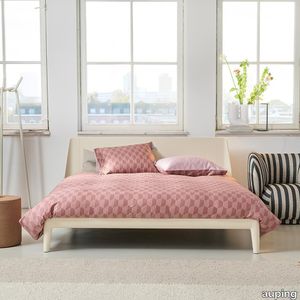
auping > Accessories
A classic duvet cover with a recurring pattern of hexagon shapes in mauve and shaded pink tints. These refined colours bring a delightful twilight effect into your bedroom. The subtly striped pattern achieves a look that is both graphic and feminine at the same time. A gentle pink has been selected ... Extra long tuck-in strip All Auping duvet covers have an extra long tuck-in strip across the entire width and on both sides. This makes it easy to tuck the duvet cover under your mattress. Cold feet are a thing of the past. You can recognize the extra long tuck-in strip by the length: 200/220. Pillowcase with double hotel closure The Auping pillowcases from the seasonal collection have a so-called double hotel closure. A hotel closure is a folded opening on the shortest side of the pillowcase. With a double hotel closure, it doesn't matter which side of your pillow you use, it always looks neat. Button down Auping duvet covers and duvets feature the button down system. These are convenient buttons and loops that you use to fasten the duvet and cover together so it won't shift. The term button down comes from fashion. It literally means "buttoned down" and often refers to the buttons on the collar of a shirt that you use to neatly fasten the collar to the shirt. Auping duvet covers have loops on the inside of the cover. Our duvets have buttons in the same places. The loops from the duvet cover can be put around these buttons so the duvet can't move around in the cover. And with these buttons and loops it is also easier to make your bed neatly. Sustainable sleeping At Auping, we dream of a rested world. Of sleeping under wonderful bedding that is made in an environmentally friendly way and under good working conditions. The covers in our spring 2023 collection carry the OEKO-TEX label as well as the BCI label, which also guarantees bedding produced in a sustainable and socially responsible manner.
Compatta Argilla

florim > Wall tile-stone-brick
<p>A passion for earth as a natural material and for rammed earth, an ancient construction technique.</p> <p>The combination of these patterns evolves into the concept of Pisé Inserti, more slabs of immense decorative impact, generated by the two-dimensional criss-crossing of exquisite, rounded geometrical forms: the designer combines the natural earthen shades with apparently random curved lines that evoke the uneven trapezia with rounded corners used by Gio Ponti.</p> <p>These are also available in the large 120x280 cm size and 6 mm thickness in three variants: Pisé Inserti A, Pisé Inserti B and Pisé Inserti C. COMPATTA’s potential is further enhanced by three-dimensional subjects of varying shapes, which can be built up into mesh-backed mosaics to create sculptural forms on walls. These extensions to the collection are called Inserti Melange, Inserti Sabbia-Argilla and Inserti Limo-Ghiaia and are produced in 9 mm thickness and 30x30 cm size.</p> <p>The collection is born from a sustainable and virtuous approach and is part of <a href="https://www.florim.com/en/company/sustainability/carbonzero-florim/">CarbonZero</a>, Florim's range of Carbon Neutral surfaces.</p> <p>The COMPATTA collection, designed by Federico Peri, combines a passion for earth as a natural material and an interest in a very ancient construction technique.<br>The primary inspiration derives from close observation of the many strata within the ground and the mixtures of elementary particles of which it consists. The design concept is completed by reference to the age-old rammed earth construction technique, used in northern Jordan since the eighth millennium BCE and widely applied in Yemen in many other desert or rural settings until the mid 19thC.<br>In this method, the raw earth is compacted inside wooden formwork to construct continuous structural walls, bearing walls or partitions inside homes, with a natural decorative effect due to the layering of the different shades of clay used. When creating his project for CEDIT, Peri was also influenced by several design inputs: from rural African homes to the clear, simple geometric forms and curved lines typical of the work of Gio Ponti, the curves central to the modernist gardens of Brazilian landscape artist Roberto Burle Marx, and the three-dimensional mosaics of English sculptor William Mitchell. In his murals in concrete, glass and recycled materials, Mitchell seems to combine some of the typical features of a variety of artistic movements, from Modernism to Brutalism, and also shows awareness of the issues concerning the structure of the landscape and the relationship with nature at the heart of Land Art. COMPATTA thus embodies strong links to the world of art and architecture, while bringing natural impressions with a remote, primitive flavour into modern living-spaces.</p>
Cielo Wall Light
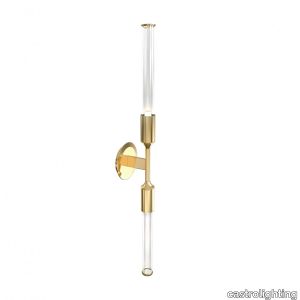
castrolighting > Wall lamp
Reveal the power of nature's majesty by inviting it inside your home with the Cielo Collection which has been inspired by nature's magnificence and its wonders - the fusion of pure elements. The Cielo Collection visualizes the concept of natural forces and their mysterious power. The fusion of pure elements – fire, ocean waves, sky, and stones – is the greatest source of inspiration. Fire creates delicacy, wave shapes stones, the sky elevates magic, and stone brings textures. Therefore, nature shapes lighting design. The Cielo Collection is a dynamic way of conceiving the world and the joy of discovery and wonder. The luxury oasis is waiting, imagine the calcite forms decorations that hang from the ceiling – stalactites with multi-coloured lighting that splits through rocks to glow in the dark. This time, Castro Lighting carries its manufacturing traditions transforming them into contemporary interior aesthetics – a minimal yet artistic expression of the modern lighting design within natural wonders. Brass finishes, textures, and glass curves – the customization options are limitless. The Cielo Wall Light proudly bears the name which in Italian is related to sky or heaven. This handmade lighting fixture is made of gold-plated brass, the strong lines create an organic movement of subtle brass tubes complementing the luxury chandelier with clear glass. If you look closely enough, the extended tubes remind dangling stalactite and stalagmite shapes. Hammered by the hands of experienced craftsmen, it is capable of transforming the living space into grand adventurous scenery. This finest lighting design is a beautiful addition to enhance modern living rooms, contemporary hallways, and luxurious hotel corridors. The Cielo handcrafted gold pendant is the perfect choice for the interiors with modern classic style, and contemporary vibes, as well as the art-deco touch. Feel the powerful energy of this pendant which brass elements complement the refinement of the interior and permitted to reveal a new meaning of beauty. Simplicity, smooth texture, and clean glass lines help define this contemporary lighting design as the signature collection fitting to the most exquisite decors.
Storie Cascina
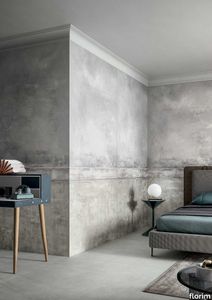
florim > Wall Paint
The faded wall fresco, damp stains in plaster. «Technological innovation enables us to reproduce on large-sized ceramic materials all the effects of wear and stratification that normally only time is able to create.» Giorgia Zanellato & Daniele Bortotto Children stare at the walls of a farmhouse, wondering what the cracks are, and whether every mark is a path and every path is a story. They think that miniature beings live in the air pockets that have formed, and the detaching plaster is like an avalanche cascading from a glacier. They don't ask why the colours are as they are, because they just had to be like that. And every square centimetre becomes the first page of an adventure that restarts at every break in the pattern. Could this be why we say that both textures and plots have twists, and stories are woven? As even children know, walls are tales. Not only do they contain adventures, emotions, moments, loves and hates and record them on their surfaces; their uneven, active surfaces generate new imaginary worlds, in which one can literally get lost. The "Storie" collection by Giorgia Zanellato and Daniele Bortotto brings this metaphor to three-dimensional life by expressing the moods, loves and hates and moments that the walls and floors of old Italian homes conserve, and capturing them in a frozen instant. The theme of time and the changes wrought in matter by the passing seasons, weather and human action have always been a strong source of inspiration for architects: some have tried to freeze it, while others have used sleight of hand to embrace it while resisting its effects, and yet others have accelerated, anticipated, directed and re-created it.<br /> Zanellato and Bortotto do all these things at once, engaging in a duel with History with a capital H, in which it is never clear who is winning: design or object, man or nature, culture or time. And it is probably this unresolved tension which makes the "Storie" designs so universal and meaningful, so intimate and yet familiar. The floor is the only thing we can be certain that everyone entering our home will touch, and at the same time it is the most intimate part, the most steeped in private happenings. They talk about having your "feet firmly on the ground". This image stands for common sense, but also a recognition of how things are, how things work. The wall is a synecdoche, too: it is the part of the home that expresses an idea of solidity, the layering of time, the passage of lives. "Storie" gives form to this metaphor by drawing a line that links the most classical of taste to a sophisticated modernity of taste and style. The two designers did a great deal of background work for this project: old Italian homes, country villas, noble palazzos, farmhouses and old factors, which become an unlimited source of motifs, colours, textures and materials. But, perhaps unconsciously, literature also re-emerges from this survey of locations, with its blend of aestheticism and decadence, with echoes of Wilde and D'Annunzio, Ruskin and Huysmans. "Storie" would be the ideal backdrop for Des Esseintes, the dandy in "A Rebours". And in fact the collection clearly has strong theatrical connections, arising partly from its storytelling connotations but also from its scene-setting potential.<br /> It represents life, which we are, have been and wish to continue to be. And it is thrilling to realise that this vision comes from the youngest designers in CEDIT's new era, who have successfully taken a confident, cultured, astute, sidelong approach to the most ancient of topics, with a persuasive effect which appears, at least, to be not at all intimidated by the many stories, the type of product they are dealing with, the catalogue in which they are included, the designers who have gone before them or, naturally, the adventures that lie concealed in the historic dwellings they reproduce. The reference to Italy, on the other hand, is in perfect harmony with the work of the brand and its past and present designers: it is intrinsic to the perfection of the production process that underlies the collection, the relationship with the brand's tradition and its local roots, and the intelligent, strategic use of its innovations in the treatment of this complex material.Child's play? Yes, but with the integrity and ability to enchant unique to specific designs, capable of an immediacy of vision and feeling that makes them little novels written in cement.
Lagoon Duvet Cover
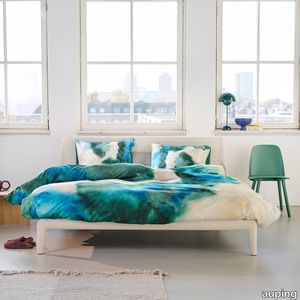
auping > Accessories
This duvet cover features an irregular pattern of beautiful blue and green bursts that peacefully flow apart and together atop a light background. Seen from above, you'd swear you were looking down upon an idyllic sandy bay. The rear side of the duvet cover and the pillows are a deep-sea green, so you... Extra long tuck-in strip All Auping duvet covers have an extra long tuck-in strip across the entire width and on both sides. This makes it easy to tuck the duvet cover under your mattress. Cold feet are a thing of the past. You can recognize the extra long tuck-in strip by the length: 200/220. Pillowcase with double hotel closure The Auping pillowcases from the seasonal collection have a so-called double hotel closure. A hotel closure is a folded opening on the shortest side of the pillowcase. With a double hotel closure, it doesn't matter which side of your pillow you use, it always looks neat. Button down Auping duvet covers and duvets feature the button down system. These are convenient buttons and loops that you use to fasten the duvet and cover together so it won't shift. The term button down comes from fashion. It literally means "buttoned down" and often refers to the buttons on the collar of a shirt that you use to neatly fasten the collar to the shirt. Auping duvet covers have loops on the inside of the cover. Our duvets have buttons in the same places. The loops from the duvet cover can be put around these buttons so the duvet can't move around in the cover. And with these buttons and loops it is also easier to make your bed neatly. Sustainable sleeping At Auping, we dream of a rested world. Of sleeping under wonderful bedding that is made in an environmentally friendly way and under good working conditions. The covers in our spring 2023 collection carry the OEKO-TEX label as well as the BCI label, which also guarantees bedding produced in a sustainable and socially responsible manner.
WILLY - Sofa bed with removable cover _ Milano Bedding
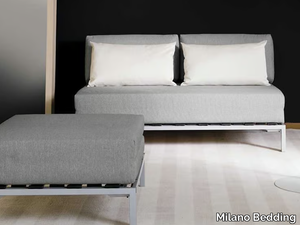
Milano Bedding > Sofa
Willy Sofa Bed by Milano Bedding The Willy sofa bed is a versatile and minimalistic piece, designed to deliver both elegance and practicality in modern interiors. With a clean, geometric silhouette and visible metal structure, this sofa bed stands out as a stylish solution for residential spaces, studio apartments, guest rooms, and hospitality environments. Materials and Construction Crafted with a powder-coated steel frame in a hammered silver finish, the structure is sturdy and designed for long-lasting durability. The base features beech plywood slats, offering ergonomic support and improved ventilation for sleeping. The mattress is made of medium-density polyurethane foam with a height of 11 cm, ensuring comfort for overnight guests. Upholstery is fully removable and available in a wide selection of fabrics, including washable options. Leather and faux leather finishes are also available, allowing customisation to suit different interior styles. Dimensions The Willy sofa bed is available in multiple sizes: Armchair bed: 80 x 102 x 85 cm (mattress: 80 x 198 x 11 cm) 2-seater: 140 x 102 x 85 cm (mattress: 140 x 198 x 11 cm) 2-seater maxi: 160 x 102 x 85 cm (mattress: 160 x 198 x 11 cm) Seat height: 45 cm. Style and Aesthetics The aesthetic of the Willy sofa bed is rooted in contemporary and industrial design. The exposed metal frame brings a bold, modern character, while the squared form and customisable upholstery offer subtle elegance. Whether upholstered in neutral tones for a refined look or in bold colours for contrast, the Willy sofa integrates easily into a variety of design concepts. Functionality The Willy transforms effortlessly from a sofa into a bed thanks to a smooth pull-out mechanism. The slatted beech base provides proper back support, while the foam mattress offers comfort suitable for daily use or occasional guests. Its compact footprint and multiple configuration options make it ideal for small-space living or multi-use rooms. Suitable Projects Perfect for contemporary living rooms, guest bedrooms, home offices, or short-term rental properties, the Willy sofa bed combines strong design identity with practicality. In hospitality settings such as boutique hotels or serviced apartments, it adds both aesthetic value and functional sleeping capacity.
Cielo Chandelier
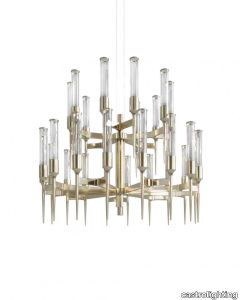
castrolighting > Ceiling lamp
Reveal the power of nature's majesty by inviting it inside your home with the Cielo Collection that has been inspired by nature's magnificence and its wonders - the fusion of pure elements. The Cielo Collection visualizes the concept of natural forces and their mysterious power. The fusion of pure elements – fire, ocean waves, sky, and stones – is the greatest source of inspiration. Fire creates delicacy, wave shapes stones, sky elevates magic, stone brings textures. Therefore, nature shapes lighting design. The Cielo Collection is the dynamic way of conceiving the world and the joy of discovery and wonder. The luxury oasis is waiting, imagine the calcite forms decorations that hang from the ceiling – stalactites with multi-coloured lighting that splits through rocks to glow in the dark. This time, Castro Lighting carries its manufacturing traditions transforming them into contemporary interior aesthetics – a minimal yet artistic expression of the modern lighting design within natural wonders. Brass finishes, textures, glass curves – the customization options are limitless. The Cielo chandelier proudly bears the name which in Italian is related to sky or heaven. This new handmade lighting version is made of gold-plated brass, featuring two levels of strong lines, complementing the luxury chandelier with clear glass. Hammered by the hands of experienced craftsmen, it is capable of transforming the living space into grand adventurous scenery. This finest lighting design is a beautiful addition to enhance modern living rooms, contemporary hallways, and luxurious hotel corridors. The Cielo handcrafted gold chandelier is the perfect choice for the interiors with modern classic style, contemporary vibes, as well as the art-deco touch. Feel the powerful energy of this suspension which brass elements complement the refinement of the interior and permit to reveal a new meaning of beauty. Simplicity, smooth texture, and clean glass lines help define this contemporary lighting design as the signature collection fitting to the most exquisite decors. VIEW FULL FAMILY
Storie Palazzo

florim > Wall Paint
The faded wall fresco, damp stains in plaster. «Technological innovation enables us to reproduce on large-sized ceramic materials all the effects of wear and stratification that normally only time is able to create.» Giorgia Zanellato & Daniele Bortotto Children stare at the walls of a farmhouse, wondering what the cracks are, and whether every mark is a path and every path is a story. They think that miniature beings live in the air pockets that have formed, and the detaching plaster is like an avalanche cascading from a glacier. They don't ask why the colours are as they are, because they just had to be like that. And every square centimetre becomes the first page of an adventure that restarts at every break in the pattern. Could this be why we say that both textures and plots have twists, and stories are woven? As even children know, walls are tales. Not only do they contain adventures, emotions, moments, loves and hates and record them on their surfaces; their uneven, active surfaces generate new imaginary worlds, in which one can literally get lost. The "Storie" collection by Giorgia Zanellato and Daniele Bortotto brings this metaphor to three-dimensional life by expressing the moods, loves and hates and moments that the walls and floors of old Italian homes conserve, and capturing them in a frozen instant. The theme of time and the changes wrought in matter by the passing seasons, weather and human action have always been a strong source of inspiration for architects: some have tried to freeze it, while others have used sleight of hand to embrace it while resisting its effects, and yet others have accelerated, anticipated, directed and re-created it.<br /> Zanellato and Bortotto do all these things at once, engaging in a duel with History with a capital H, in which it is never clear who is winning: design or object, man or nature, culture or time. And it is probably this unresolved tension which makes the "Storie" designs so universal and meaningful, so intimate and yet familiar. The floor is the only thing we can be certain that everyone entering our home will touch, and at the same time it is the most intimate part, the most steeped in private happenings. They talk about having your "feet firmly on the ground". This image stands for common sense, but also a recognition of how things are, how things work. The wall is a synecdoche, too: it is the part of the home that expresses an idea of solidity, the layering of time, the passage of lives. "Storie" gives form to this metaphor by drawing a line that links the most classical of taste to a sophisticated modernity of taste and style. The two designers did a great deal of background work for this project: old Italian homes, country villas, noble palazzos, farmhouses and old factors, which become an unlimited source of motifs, colours, textures and materials. But, perhaps unconsciously, literature also re-emerges from this survey of locations, with its blend of aestheticism and decadence, with echoes of Wilde and D'Annunzio, Ruskin and Huysmans. "Storie" would be the ideal backdrop for Des Esseintes, the dandy in "A Rebours". And in fact the collection clearly has strong theatrical connections, arising partly from its storytelling connotations but also from its scene-setting potential.<br /> It represents life, which we are, have been and wish to continue to be. And it is thrilling to realise that this vision comes from the youngest designers in CEDIT's new era, who have successfully taken a confident, cultured, astute, sidelong approach to the most ancient of topics, with a persuasive effect which appears, at least, to be not at all intimidated by the many stories, the type of product they are dealing with, the catalogue in which they are included, the designers who have gone before them or, naturally, the adventures that lie concealed in the historic dwellings they reproduce. The reference to Italy, on the other hand, is in perfect harmony with the work of the brand and its past and present designers: it is intrinsic to the perfection of the production process that underlies the collection, the relationship with the brand's tradition and its local roots, and the intelligent, strategic use of its innovations in the treatment of this complex material.Child's play? Yes, but with the integrity and ability to enchant unique to specific designs, capable of an immediacy of vision and feeling that makes them little novels written in cement.
Compatta Pisé Limo

florim > Wall tile-stone-brick
<p>A passion for earth as a natural material and for rammed earth, an ancient construction technique.</p> <p>The combination of these patterns evolves into the concept of Pisé Inserti, more slabs of immense decorative impact, generated by the two-dimensional criss-crossing of exquisite, rounded geometrical forms: the designer combines the natural earthen shades with apparently random curved lines that evoke the uneven trapezia with rounded corners used by Gio Ponti.</p> <p>These are also available in the large 120x280 cm size and 6 mm thickness in three variants: Pisé Inserti A, Pisé Inserti B and Pisé Inserti C. COMPATTA’s potential is further enhanced by three-dimensional subjects of varying shapes, which can be built up into mesh-backed mosaics to create sculptural forms on walls. These extensions to the collection are called Inserti Melange, Inserti Sabbia-Argilla and Inserti Limo-Ghiaia and are produced in 9 mm thickness and 30x30 cm size.</p> <p>The collection is born from a sustainable and virtuous approach and is part of <a href="https://www.florim.com/en/company/sustainability/carbonzero-florim/">CarbonZero</a>, Florim's range of Carbon Neutral surfaces.</p> <p>The COMPATTA collection, designed by Federico Peri, combines a passion for earth as a natural material and an interest in a very ancient construction technique.<br>The primary inspiration derives from close observation of the many strata within the ground and the mixtures of elementary particles of which it consists. The design concept is completed by reference to the age-old rammed earth construction technique, used in northern Jordan since the eighth millennium BCE and widely applied in Yemen in many other desert or rural settings until the mid 19thC.<br>In this method, the raw earth is compacted inside wooden formwork to construct continuous structural walls, bearing walls or partitions inside homes, with a natural decorative effect due to the layering of the different shades of clay used. When creating his project for CEDIT, Peri was also influenced by several design inputs: from rural African homes to the clear, simple geometric forms and curved lines typical of the work of Gio Ponti, the curves central to the modernist gardens of Brazilian landscape artist Roberto Burle Marx, and the three-dimensional mosaics of English sculptor William Mitchell. In his murals in concrete, glass and recycled materials, Mitchell seems to combine some of the typical features of a variety of artistic movements, from Modernism to Brutalism, and also shows awareness of the issues concerning the structure of the landscape and the relationship with nature at the heart of Land Art. COMPATTA thus embodies strong links to the world of art and architecture, while bringing natural impressions with a remote, primitive flavour into modern living-spaces.</p>
Torii Nest "Outdoor"
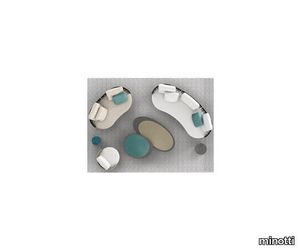
minotti > Sofa
Designed for indoor environments in 2020, Torii Nest migrates to open-air living spaces, bringing to life an entire family of seats. With structural details linked to Japanese tradition, the chairs and sofas play with round edged volumes, thin profiles and the apparent formal simplicity of an extremely intricate design. The painted tubular steel frame of the woven cord backrest in the shades Ecru, Dark Brown and Oil Green sports a design inspired by cane, but with a larger mesh that lets light and air through. It sits on a base in natural teak or Dark Brown mahogany, supported by painted aluminium legs with a shiny, Bronze-coloured, anti-touch finish. With its sophisticated, light look, Torii Nest Outdoor comes in pieces of different sizes and types, from fixed and swivel armchair to two-seater sofa with curved silhouette and round chaise-longue, all designed to meet a variety of requirements, both in terms of functionality and ergonomics. The ethereal appearance of these furnishing pieces dialogues harmoniously with their extreme materiality: the backrest, an enveloping nest, embraces and encloses the soft cushions resting on a solid natural teak frame. A succession of materials with a strong tactile impact and a welcoming feel, as if these sofas were primarily places in which to let go and relax. A design that is at times romantic and at times contemporary, thanks to its compact proportions, it easily fits into the decor on metropolitan terraces and in hospitality settings, satisfying both the most classic and the most modern aesthetic tastes.
Storie Masseria

florim > Wall Paint
The faded wall fresco, damp stains in plaster. «Technological innovation enables us to reproduce on large-sized ceramic materials all the effects of wear and stratification that normally only time is able to create.» Giorgia Zanellato & Daniele Bortotto Children stare at the walls of a farmhouse, wondering what the cracks are, and whether every mark is a path and every path is a story. They think that miniature beings live in the air pockets that have formed, and the detaching plaster is like an avalanche cascading from a glacier. They don't ask why the colours are as they are, because they just had to be like that. And every square centimetre becomes the first page of an adventure that restarts at every break in the pattern. Could this be why we say that both textures and plots have twists, and stories are woven? As even children know, walls are tales. Not only do they contain adventures, emotions, moments, loves and hates and record them on their surfaces; their uneven, active surfaces generate new imaginary worlds, in which one can literally get lost. The "Storie" collection by Giorgia Zanellato and Daniele Bortotto brings this metaphor to three-dimensional life by expressing the moods, loves and hates and moments that the walls and floors of old Italian homes conserve, and capturing them in a frozen instant. The theme of time and the changes wrought in matter by the passing seasons, weather and human action have always been a strong source of inspiration for architects: some have tried to freeze it, while others have used sleight of hand to embrace it while resisting its effects, and yet others have accelerated, anticipated, directed and re-created it.<br /> Zanellato and Bortotto do all these things at once, engaging in a duel with History with a capital H, in which it is never clear who is winning: design or object, man or nature, culture or time. And it is probably this unresolved tension which makes the "Storie" designs so universal and meaningful, so intimate and yet familiar. The floor is the only thing we can be certain that everyone entering our home will touch, and at the same time it is the most intimate part, the most steeped in private happenings. They talk about having your "feet firmly on the ground". This image stands for common sense, but also a recognition of how things are, how things work. The wall is a synecdoche, too: it is the part of the home that expresses an idea of solidity, the layering of time, the passage of lives. "Storie" gives form to this metaphor by drawing a line that links the most classical of taste to a sophisticated modernity of taste and style. The two designers did a great deal of background work for this project: old Italian homes, country villas, noble palazzos, farmhouses and old factors, which become an unlimited source of motifs, colours, textures and materials. But, perhaps unconsciously, literature also re-emerges from this survey of locations, with its blend of aestheticism and decadence, with echoes of Wilde and D'Annunzio, Ruskin and Huysmans. "Storie" would be the ideal backdrop for Des Esseintes, the dandy in "A Rebours". And in fact the collection clearly has strong theatrical connections, arising partly from its storytelling connotations but also from its scene-setting potential.<br /> It represents life, which we are, have been and wish to continue to be. And it is thrilling to realise that this vision comes from the youngest designers in CEDIT's new era, who have successfully taken a confident, cultured, astute, sidelong approach to the most ancient of topics, with a persuasive effect which appears, at least, to be not at all intimidated by the many stories, the type of product they are dealing with, the catalogue in which they are included, the designers who have gone before them or, naturally, the adventures that lie concealed in the historic dwellings they reproduce. The reference to Italy, on the other hand, is in perfect harmony with the work of the brand and its past and present designers: it is intrinsic to the perfection of the production process that underlies the collection, the relationship with the brand's tradition and its local roots, and the intelligent, strategic use of its innovations in the treatment of this complex material.Child's play? Yes, but with the integrity and ability to enchant unique to specific designs, capable of an immediacy of vision and feeling that makes them little novels written in cement.
Oltremare Panchetta
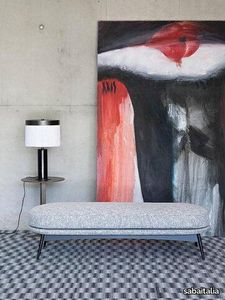
sabaitalia > Armchair
The seating collection “Oltremare” designed by Antonio Marras and produced in collaboration with Saba, stems from a far-away past and place, full of history, recollection, memories overflowing with suggestions and visions. And this is how Antonio Marras presented an object so dear to him that he defines a sacred-idol, that narrates of his land, of his sea, but mostly, of his story. We named it Oltremare, because all things have a soul and every soul has a name. Oltremare encloses within its inlets the classic and the modern. The curve is a line that can be tamed: it forms a wave, a fold, it creates a place but it also offers an escape route. In our utopian world we investigated the relationship between the curved line and the act of seating, asymmetric shapes that become backrests and sink into extremely comfortable seats pushing past the rectangular schemes so dear to the sober lines of designing sofas. The asymmetric curves that enclose it are the inspirations for the Oltremare armchair that completes the collection alongside a padded bench. A comfortable nest suspended on a slim varnished metal base, whose essential lines render, by contract, the armchair’s silhouette even more interesting. Oltremare is a seating system that, even though winks at the past, it communicates a strong contemporary soul and is suitable by nature to various interpretations. Fully removable covers.
Storie Villa

florim > Wall Paint
The faded wall fresco, damp stains in plaster. «Technological innovation enables us to reproduce on large-sized ceramic materials all the effects of wear and stratification that normally only time is able to create.» Giorgia Zanellato & Daniele Bortotto Children stare at the walls of a farmhouse, wondering what the cracks are, and whether every mark is a path and every path is a story. They think that miniature beings live in the air pockets that have formed, and the detaching plaster is like an avalanche cascading from a glacier. They don't ask why the colours are as they are, because they just had to be like that. And every square centimetre becomes the first page of an adventure that restarts at every break in the pattern. Could this be why we say that both textures and plots have twists, and stories are woven? As even children know, walls are tales. Not only do they contain adventures, emotions, moments, loves and hates and record them on their surfaces; their uneven, active surfaces generate new imaginary worlds, in which one can literally get lost. The "Storie" collection by Giorgia Zanellato and Daniele Bortotto brings this metaphor to three-dimensional life by expressing the moods, loves and hates and moments that the walls and floors of old Italian homes conserve, and capturing them in a frozen instant. The theme of time and the changes wrought in matter by the passing seasons, weather and human action have always been a strong source of inspiration for architects: some have tried to freeze it, while others have used sleight of hand to embrace it while resisting its effects, and yet others have accelerated, anticipated, directed and re-created it.<br /> Zanellato and Bortotto do all these things at once, engaging in a duel with History with a capital H, in which it is never clear who is winning: design or object, man or nature, culture or time. And it is probably this unresolved tension which makes the "Storie" designs so universal and meaningful, so intimate and yet familiar. The floor is the only thing we can be certain that everyone entering our home will touch, and at the same time it is the most intimate part, the most steeped in private happenings. They talk about having your "feet firmly on the ground". This image stands for common sense, but also a recognition of how things are, how things work. The wall is a synecdoche, too: it is the part of the home that expresses an idea of solidity, the layering of time, the passage of lives. "Storie" gives form to this metaphor by drawing a line that links the most classical of taste to a sophisticated modernity of taste and style. The two designers did a great deal of background work for this project: old Italian homes, country villas, noble palazzos, farmhouses and old factors, which become an unlimited source of motifs, colours, textures and materials. But, perhaps unconsciously, literature also re-emerges from this survey of locations, with its blend of aestheticism and decadence, with echoes of Wilde and D'Annunzio, Ruskin and Huysmans. "Storie" would be the ideal backdrop for Des Esseintes, the dandy in "A Rebours". And in fact the collection clearly has strong theatrical connections, arising partly from its storytelling connotations but also from its scene-setting potential.<br /> It represents life, which we are, have been and wish to continue to be. And it is thrilling to realise that this vision comes from the youngest designers in CEDIT's new era, who have successfully taken a confident, cultured, astute, sidelong approach to the most ancient of topics, with a persuasive effect which appears, at least, to be not at all intimidated by the many stories, the type of product they are dealing with, the catalogue in which they are included, the designers who have gone before them or, naturally, the adventures that lie concealed in the historic dwellings they reproduce. The reference to Italy, on the other hand, is in perfect harmony with the work of the brand and its past and present designers: it is intrinsic to the perfection of the production process that underlies the collection, the relationship with the brand's tradition and its local roots, and the intelligent, strategic use of its innovations in the treatment of this complex material.Child's play? Yes, but with the integrity and ability to enchant unique to specific designs, capable of an immediacy of vision and feeling that makes them little novels written in cement.
LARRY - 3 seater sofa bed _ Milano Bedding
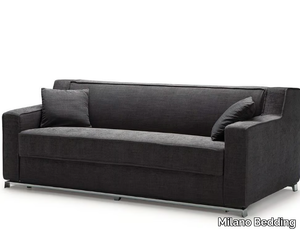
Milano Bedding > Sofa
LARRY by Milano Bedding – Clean Lines, Wide Armrests, and Real-Bed Comfort Name: Larry Material: Solid wood frame, polyurethane foam, steel Lampolet mechanism Finishing: Fixed or removable fabric/leather upholstery, painted metal legs Sizes (cm): Width 190–225 | Depth 100 | Height 84 | Bed size 140×200 or 160×200 Weight: Approx. 115–130 kg Designed in: Italy Collection: Milano Bedding Sofa Beds Lead Time: 30 days 2D/3D Files: Available for download Robust Elegance with Hidden Functionality The Larry sofa bed by Milano Bedding brings together modern simplicity, broad proportions, and exceptional comfort. Its signature features—generous armrests, linear structure, and deep seat—make it ideal for urban residences, design hotels, and serviced apartments. Inside, Larry hides a high-quality 17 cm thick mattress that unfolds easily using the brand’s patented Lampolet mechanism. The bed opens in one motion, without removing seat or back cushions, offering a true sleeping solution suitable for everyday use. Materials, Upholstery & Build Quality Constructed with a solid wood frame and a durable steel opening system, Larry is built for longevity in both private and contract settings. The seat and back cushions are made of polyurethane foam in differentiated densities, ensuring balanced support and comfort. The sofa is available with removable or fixed upholstery, in Milano Bedding’s wide range of fabrics and leathers. From neutral wools and natural linens to bold velvets and contract-grade textiles, the material palette allows Larry to blend into any interior design vision. Slim painted metal legs support the structure while adding a sleek, modern edge. Suitable for Hospitality, Residential & Contract Projects Larry’s clean form and smart proportions make it a perfect match for: Hotel rooms, suites, and short-stay apartments Luxury rentals, co-living spaces, or student housing Home offices, family lounges, or guest bedrooms Reception lounges or creative studio waiting areas Its wide armrests and structured shape make it ideal for larger rooms that need a grounding, comfortable anchor piece that’s also highly functional. Visual Style & Interior Harmony Larry’s aesthetic is firmly rooted in contemporary minimalism with a touch of architectural solidity. The strong geometry, broad armrests, and deep seat work well in Scandinavian, Japandi, or urban loft-style interiors. Whether upholstered in monochrome fabrics for a minimalist look or in rich hues for a bolder presence, Larry adapts easily. It can serve as the focal point of a lounge or blend harmoniously into a layered residential palette. Key Features & Optional Elements Converts to a 140×200 cm or 160×200 cm bed 17 cm thick mattress in polyurethane or memory foam Quick-open Lampolet mechanism – no need to remove cushions Available with removable covers for contract use Optional headrests, scatter cushions, and bolsters on request Alternatives with Similar Functionality Looking for variations in size or styling? Explore: Goodman – More compact geometry with minimalist arms Marsalis – Mid-century style with elegant structure Charles – Slim profile for smaller spaces Jarreau – Deep seat and sculptural shape for bold interiors All Milano Bedding products include 2D and 3D files to simplify space planning and client presentations. Larry by Milano Bedding is the ideal solution when you need a generously proportioned, modern sofa bed that combines comfort, visual impact, and daily performance—perfect for both refined residential and demanding hospitality environments.
Oltremare
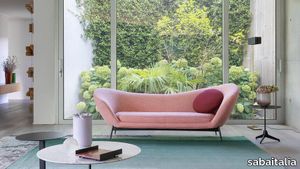
sabaitalia > Sofa
The seating collection “Oltremare” designed by Antonio Marras and produced in collaboration with Saba, stems from a far-away past and place, full of history, recollection, memories overflowing with suggestions and visions. And this is how Antonio Marras presented an object so dear to him that he defines a sacred-idol, that narrates of his land, of his sea, but mostly, of his story. We named it Oltremare, because all things have a soul and every soul has a name. Oltremare encloses within its inlets the classic and the modern. The curve is a line that can be tamed: it forms a wave, a fold, it creates a place but it also offers an escape route. In our utopian world we investigated the relationship between the curved line and the act of seating, asymmetric shapes that become backrests and sink into extremely comfortable seats pushing past the rectangular schemes so dear to the sober lines of designing sofas. The asymmetric curves that enclose it are the inspirations for the Oltremare armchair that completes the collection alongside a padded bench. A comfortable nest suspended on a slim varnished metal base, whose essential lines render, by contract, the armchair’s silhouette even more interesting. Oltremare is a seating system that, even though winks at the past, it communicates a strong contemporary soul and is suitable by nature to various interpretations. Fully removable covers.
RAPA M - Stackable sled base ash chair _ Zilio A&C
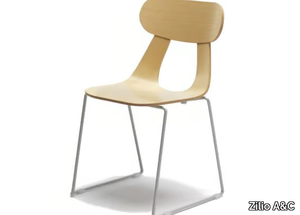
Zilio A&C > Chair
Zilio A&C Rapa M Chair – A Sleek, Stackable Seating Solution for Hospitality & Contract Spaces Introduction to the Rapa M Chair Designed by Mentsen, the Rapa M Chair by Zilio A&C is a modern, functional, and stackable plywood chair with a sleek metal sled base. This versatile seating solution balances comfort, durability, and elegant craftsmanship, making it ideal for hospitality, office, and contract interiors. With a carefully engineered plywood shell, the Rapa M Chair is designed to provide exceptional support and stability, utilizing both traditional woodworking techniques and advanced plywood manufacturing technologies. Design & Key Features Stackable design – Space-saving and practical, ideal for high-traffic areas and flexible seating arrangements. Distinctive curved plywood shell – Offers ergonomic support, with a smooth transition from seat to backrest. Interlocked joint construction – Provides enhanced durability and structural integrity. Available in two versions: Wooden base – A warm, organic aesthetic. Metal sled base (Rapa M) – A lightweight yet strong frame, perfect for commercial and contract settings. Natural or lacquered finish, offering a range of customization options. Ideal for contract, hospitality, and public seating. Dimensions & Specifications Width: 500 mm Depth: 515 mm Height: 815 mm Seat Material: Ash veneered plywood Base Material: Powder-coated steel sled frame Stackable: Yes Material & Finish Options The Rapa M Chair is crafted with high-quality materials, ensuring both style and longevity: Seat Finishes: Natural Ash Plywood – A light, Scandinavian-inspired wood finish, emphasizing the natural grain of ash. Lacquered Ash Plywood – A customizable, refined finish, available in a selection of colours to match various design palettes. Base Finishes: Powder-Coated Steel – A durable, minimalist metal frame for modern interiors. Where to Use the Rapa M Chair? With its minimalist aesthetic, ergonomic shape, and stackable functionality, the Rapa M Chair is an excellent choice for a variety of contract and hospitality settings: Restaurants & Cafés – A stylish and practical chair for high-traffic dining environments. Conference & Meeting Rooms – Provides comfortable, stackable seating for flexible workspaces. Hotel Lobbies & Lounges – A refined seating option for guest waiting areas. Educational Spaces & Training Rooms – Ideal for lecture halls and seminar spaces. Co-Working & Office Interiors – Perfect for breakout zones and collaborative spaces. Alternative Options For designers seeking similar stackable chairs with a refined plywood shell, consider: Muuto Visu Chair – A curved plywood seat with a lightweight frame. Pedrali Babila Chair – A minimalist plywood chair with a contemporary appeal. Andreu World Flex Chair – A modern ergonomic chair with a sleek profile.
Cielo Suspension
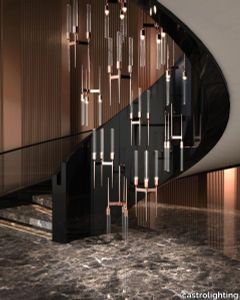
castrolighting > Ceiling lamp
Reveal the power of nature's majesty by inviting it inside your home with the Cielo Collection that has been inspired by nature's magnificence and its wonders - the fusion of pure elements. The Cielo Collection visualizes the concept of natural forces and their mysterious power. The fusion of pure elements – fire, ocean waves, sky, and stones – is the greatest source of inspiration. Fire creates delicacy, wave shapes stones, sky elevates magic, stone brings textures. Therefore, nature shapes lighting design. The Cielo Collection is the dynamic way of conceiving the world and the joy of discovery and wonder. The luxury oasis is waiting, imagine the calcite forms decorations that hang from the ceiling – stalactites with multi-coloured lighting that splits through rocks to glow in the dark. This time, Castro Lighting carries its manufacturing traditions transforming them into contemporary interior aesthetics – a minimal yet artistic expression of the modern lighting design within natural wonders. Brass finishes, textures, glass curves – the customization options are limitless. The Cielo suspension lamp proudly bears the name which in Italian is related to sky or heaven. This handmade lighting fixture is made of gold-plated brass, the strong lines create an organic movement of subtle brass tubes complementing the luxury chandelier with clear glass. If you look closely enough, the extended tubes remind dangling stalactite and stalagmite shapes. Hammered by the hands of experienced craftsmen, it is capable of transforming the living space into grand adventurous scenery. This finest lighting design is a beautiful addition to complement the hotel lobby, large hallways, long staircases, or the spacious living room. The Cielo handcrafted gold suspension is the perfect choice for the interiors with modern classic style, contemporary vibes, as well as the art-deco touch. Feel the powerful energy of this suspension which brass elements complement the refinement of the interior and permit to reveal a new meaning of beauty. Simplicity, smooth texture, and clean glass lines help define this contemporary lighting design as the signature collection fitting to the most exquisite decors. #euroluce2023 VIEW FULL FAMILY #hotel
Torii
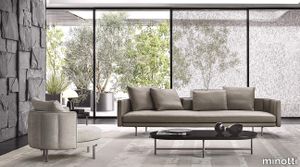
minotti > Sofa
Airy, with constructive details linked to Japanese tradition, the Torii modular seats play with round edged volumes, thin profiles and the apparent formal simplicity of an extremely detailed design. The metal structure of the legs of the seats and tables is Nendo’s nod to the image of the “torii”, the entrance gate to Shinto shrines in Japan. With an interlocking game, the horizontal elements are laid on the vertical supports, ensuring a sophisticated visual lightness that accommodates the padded volume, characterised by couture craftsmanship. The Torii family includes sofas - with high or low backrest and a linear shape, rounded at the arms - inclined sofas with a combination of two different depths, armchairs and lounge and dining little armchairs, ottomans, coffee tables, and a slender, oval-shaped console table, ideal for placing anywhere in the living area. The varied range of products makes it possible to design a flexible layout, in which the individual elements can also be combined to create a strong visual unity. The metal frame found in the components of the Torii family evokes the image of the “Senbon Torii, the wooden colonnade that forms a gallery made up of 1,000 vermilion torii gates”, as Nendo reminds us. The slim backrest features vertical quilting and a piping running along the perimeter of the cushioning, underlining the couture quality of the craftsmanship. The eco-leather and eco-nubuck piping is in a slightly contrasting colour, but in the same shade as the fabric, if combined with a textile covering, whereas the leather versions come in the same shade when combined with leather upholstery. All the upholstered elements of the system can be customised by choosing the covering: 100% fabric or leather, or in fabric with a leather base. The seats can be accessorised with leather magazine caddy, crafted with fine luggage-crafting techniques and enriched with the same metal details as the base. The end of the horizontal metal element of the legs is designed so that it almost holds the backrest and seat, recalling the Kigumi technique, borrowed from the Japanese tradition of wood construction. A small decorative disk with Black-Nickel finish, in the form of a jewel-like button located at the end, adds a precious detail to the ensemble, and creates a series of contrasts with the Bronze colour varnished metal finish of the legs. The armchairs and swivel armchairs in the form of a perfect circle were designed to meet a variety of requirements, both in terms of functionality and ergonomics, available in a range of different types. The seats - in the Bergère, Large, Medium and Small versions - and the Dining, Dining Large and Lounge little armchairs are the result of the in-depth research carried out to find the best way to express the sophisticated simplicity of the craftsmanship. The base is available in leather or fabric. The extension of the base of some elements features a top in Calacatta or Stone Grey marble with a matt polyester lacquer finish, crafted with a careful study of its proportions, thickness and structural details so that it blends seamlessly into the seat, also from an aesthetic point of view. The Small armchair is also available in the Torii Nest version with braided leather backrest and a pattern inspired by Vienna straw, inserted in a solid ash wood frame that sits on a base in the same material. The Torii coffee tables also feature the same structural style details as the seats, reflected in the metal frame with Bronze colour varnished finish and details in Black-Nickel metal. Available in different sizes, ranging up to an impressive diameter of 120 cm, and different heights, they feature a top in Calacatta or Stone Grey marble with matt polyester finish, in Black pâte de verre or in Liquorice colour brushed ash wood, enclosed by a Liquorice colour matt lacquered frame.
Compatta Ghiaia

florim > Wall tile-stone-brick
<p>A passion for earth as a natural material and for rammed earth, an ancient construction technique.</p> <p>The combination of these patterns evolves into the concept of Pisé Inserti, more slabs of immense decorative impact, generated by the two-dimensional criss-crossing of exquisite, rounded geometrical forms: the designer combines the natural earthen shades with apparently random curved lines that evoke the uneven trapezia with rounded corners used by Gio Ponti.</p> <p>These are also available in the large 120x280 cm size and 6 mm thickness in three variants: Pisé Inserti A, Pisé Inserti B and Pisé Inserti C. COMPATTA’s potential is further enhanced by three-dimensional subjects of varying shapes, which can be built up into mesh-backed mosaics to create sculptural forms on walls. These extensions to the collection are called Inserti Melange, Inserti Sabbia-Argilla and Inserti Limo-Ghiaia and are produced in 9 mm thickness and 30x30 cm size.</p> <p>The collection is born from a sustainable and virtuous approach and is part of <a href="https://www.florim.com/en/company/sustainability/carbonzero-florim/">CarbonZero</a>, Florim's range of Carbon Neutral surfaces.</p> <p>The COMPATTA collection, designed by Federico Peri, combines a passion for earth as a natural material and an interest in a very ancient construction technique.<br>The primary inspiration derives from close observation of the many strata within the ground and the mixtures of elementary particles of which it consists. The design concept is completed by reference to the age-old rammed earth construction technique, used in northern Jordan since the eighth millennium BCE and widely applied in Yemen in many other desert or rural settings until the mid 19thC.<br>In this method, the raw earth is compacted inside wooden formwork to construct continuous structural walls, bearing walls or partitions inside homes, with a natural decorative effect due to the layering of the different shades of clay used. When creating his project for CEDIT, Peri was also influenced by several design inputs: from rural African homes to the clear, simple geometric forms and curved lines typical of the work of Gio Ponti, the curves central to the modernist gardens of Brazilian landscape artist Roberto Burle Marx, and the three-dimensional mosaics of English sculptor William Mitchell. In his murals in concrete, glass and recycled materials, Mitchell seems to combine some of the typical features of a variety of artistic movements, from Modernism to Brutalism, and also shows awareness of the issues concerning the structure of the landscape and the relationship with nature at the heart of Land Art. COMPATTA thus embodies strong links to the world of art and architecture, while bringing natural impressions with a remote, primitive flavour into modern living-spaces.</p>
OC - Round wooden high table _ Zilio A&C
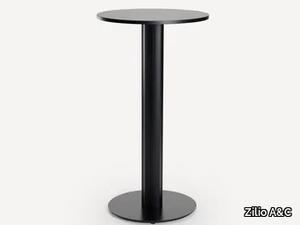
Zilio A&C > Table
Zilio A&C OC Table Collection – A Statement Piece for Hospitality Spaces Introduction to the OC Table Collection The OC table collection by Zilio A&C, designed by Mentsen in 2020, is a refined and versatile range of tables created specifically for hospitality environments. With a clean, modern design and a touch of classical elegance, these tables are ideal for restaurants, bars, lounges, and hotel lobbies, offering a blend of contemporary simplicity and timeless craftsmanship. Design and Key Features The OC table is defined by its bold, oversized octagonal central column, which features gently fluted facets, reminiscent of classical architectural detailing. This column, crafted from solid ash, brings a sense of sophistication while ensuring durability. Paired with a sleek round steel base, the design achieves a perfect balance between sturdiness and aesthetic appeal. The tabletop options include: Circular or square designs, catering to different spatial requirements. Finishes in ash veneer or smooth MDF board, available in natural, lacquered, or stained ash for a customized look. A selection of sizes and heights, making the OC table adaptable to various hospitality and contract settings. Available Variants & Dimensions The OC table collection comes in multiple configurations to suit different applications, from dining and bar areas to casual lounge spaces: Dining Table (Standard Height) Circular: Ø750 mm x H750 mm Square: W600 mm x D600 mm x H750 mm Bar Table (High) W600 mm x D600 mm x H1100 mm Ideal for bar areas, café counters, and casual standing spaces. Coffee Table (Low) Circular: Ø750 mm x H350 mm A perfect lounge table for hotel lobbies, waiting areas, and contemporary lounges. The collection offers a cohesive design language across different table heights, allowing designers to create harmonious interiors. Materials & Finishes Each table in the OC collection is made with premium materials to ensure longevity and visual appeal: Base: Steel, providing a stable foundation. Central Column: Solid ash wood, featuring the distinctive octagonal shape with fluted detailing. Tabletop: Ash veneer or smooth MDF board, offering durability and an elegant surface. Finish Options: Natural ash – Showcasing the raw beauty of wood grain. Lacquered ash – A polished, refined finish for contemporary interiors. Stained ash – Available in various tones to match diverse design schemes. Where to Use the OC Table? Thanks to its minimalist yet grand aesthetic, the OC collection is suitable for a wide range of hospitality and contract spaces: Restaurants & Cafés – A sleek dining option with strong visual presence. Hotel Lounges & Lobbies – The coffee table version complements relaxed seating areas. Bars & High-End Cocktail Lounges – The bar-height model provides a stylish yet functional surface. Co-working & Business Spaces – Works well in breakout zones or contemporary meeting areas. Alternative Options For designers looking for similar minimalist yet elegant hospitality tables, consider: Pedrali Arki Table – A modern industrial-style table with a clean-lined aesthetic. Andreu World Reverse Table – A sculptural design with high-end finishes. Magis Tavolo XZ3 – A lightweight option with a wire base. Conclusion The Zilio A&C OC Table Collection brings a sophisticated, timeless design to hospitality and contract spaces, combining the beauty of solid ash craftsmanship with the modern simplicity of steel elements. Its versatile sizing and height variations make it a go-to choice for interior designers looking to create cohesive and stylish commercial environments. Additionally, 2D and 3D files are available for download, making it easy for designers to integrate these tables into their projects.
Storie Castello

florim > Wall Paint
The faded wall fresco, damp stains in plaster. «Technological innovation enables us to reproduce on large-sized ceramic materials all the effects of wear and stratification that normally only time is able to create.» Giorgia Zanellato & Daniele Bortotto Children stare at the walls of a farmhouse, wondering what the cracks are, and whether every mark is a path and every path is a story. They think that miniature beings live in the air pockets that have formed, and the detaching plaster is like an avalanche cascading from a glacier. They don't ask why the colours are as they are, because they just had to be like that. And every square centimetre becomes the first page of an adventure that restarts at every break in the pattern. Could this be why we say that both textures and plots have twists, and stories are woven? As even children know, walls are tales. Not only do they contain adventures, emotions, moments, loves and hates and record them on their surfaces; their uneven, active surfaces generate new imaginary worlds, in which one can literally get lost. The "Storie" collection by Giorgia Zanellato and Daniele Bortotto brings this metaphor to three-dimensional life by expressing the moods, loves and hates and moments that the walls and floors of old Italian homes conserve, and capturing them in a frozen instant. The theme of time and the changes wrought in matter by the passing seasons, weather and human action have always been a strong source of inspiration for architects: some have tried to freeze it, while others have used sleight of hand to embrace it while resisting its effects, and yet others have accelerated, anticipated, directed and re-created it.<br /> Zanellato and Bortotto do all these things at once, engaging in a duel with History with a capital H, in which it is never clear who is winning: design or object, man or nature, culture or time. And it is probably this unresolved tension which makes the "Storie" designs so universal and meaningful, so intimate and yet familiar. The floor is the only thing we can be certain that everyone entering our home will touch, and at the same time it is the most intimate part, the most steeped in private happenings. They talk about having your "feet firmly on the ground". This image stands for common sense, but also a recognition of how things are, how things work. The wall is a synecdoche, too: it is the part of the home that expresses an idea of solidity, the layering of time, the passage of lives. "Storie" gives form to this metaphor by drawing a line that links the most classical of taste to a sophisticated modernity of taste and style. The two designers did a great deal of background work for this project: old Italian homes, country villas, noble palazzos, farmhouses and old factors, which become an unlimited source of motifs, colours, textures and materials. But, perhaps unconsciously, literature also re-emerges from this survey of locations, with its blend of aestheticism and decadence, with echoes of Wilde and D'Annunzio, Ruskin and Huysmans. "Storie" would be the ideal backdrop for Des Esseintes, the dandy in "A Rebours". And in fact the collection clearly has strong theatrical connections, arising partly from its storytelling connotations but also from its scene-setting potential.<br /> It represents life, which we are, have been and wish to continue to be. And it is thrilling to realise that this vision comes from the youngest designers in CEDIT's new era, who have successfully taken a confident, cultured, astute, sidelong approach to the most ancient of topics, with a persuasive effect which appears, at least, to be not at all intimidated by the many stories, the type of product they are dealing with, the catalogue in which they are included, the designers who have gone before them or, naturally, the adventures that lie concealed in the historic dwellings they reproduce. The reference to Italy, on the other hand, is in perfect harmony with the work of the brand and its past and present designers: it is intrinsic to the perfection of the production process that underlies the collection, the relationship with the brand's tradition and its local roots, and the intelligent, strategic use of its innovations in the treatment of this complex material.Child's play? Yes, but with the integrity and ability to enchant unique to specific designs, capable of an immediacy of vision and feeling that makes them little novels written in cement.
OC - Square wooden table _ Zilio A&C

Zilio A&C > Table
Zilio A&C OC Table Collection – A Statement Piece for Hospitality Spaces Introduction to the OC Table Collection The OC table collection by Zilio A&C, designed by Mentsen in 2020, is a refined and versatile range of tables created specifically for hospitality environments. With a clean, modern design and a touch of classical elegance, these tables are ideal for restaurants, bars, lounges, and hotel lobbies, offering a blend of contemporary simplicity and timeless craftsmanship. Design and Key Features The OC table is defined by its bold, oversized octagonal central column, which features gently fluted facets, reminiscent of classical architectural detailing. This column, crafted from solid ash, brings a sense of sophistication while ensuring durability. Paired with a sleek round steel base, the design achieves a perfect balance between sturdiness and aesthetic appeal. The tabletop options include: Circular or square designs, catering to different spatial requirements. Finishes in ash veneer or smooth MDF board, available in natural, lacquered, or stained ash for a customized look. A selection of sizes and heights, making the OC table adaptable to various hospitality and contract settings. Available Variants & Dimensions The OC table collection comes in multiple configurations to suit different applications, from dining and bar areas to casual lounge spaces: Dining Table (Standard Height) Circular: Ø750 mm x H750 mm Square: W600 mm x D600 mm x H750 mm Bar Table (High) W600 mm x D600 mm x H1100 mm Ideal for bar areas, café counters, and casual standing spaces. Coffee Table (Low) Circular: Ø750 mm x H350 mm A perfect lounge table for hotel lobbies, waiting areas, and contemporary lounges. The collection offers a cohesive design language across different table heights, allowing designers to create harmonious interiors. Materials & Finishes Each table in the OC collection is made with premium materials to ensure longevity and visual appeal: Base: Steel, providing a stable foundation. Central Column: Solid ash wood, featuring the distinctive octagonal shape with fluted detailing. Tabletop: Ash veneer or smooth MDF board, offering durability and an elegant surface. Finish Options: Natural ash – Showcasing the raw beauty of wood grain. Lacquered ash – A polished, refined finish for contemporary interiors. Stained ash – Available in various tones to match diverse design schemes. Where to Use the OC Table? Thanks to its minimalist yet grand aesthetic, the OC collection is suitable for a wide range of hospitality and contract spaces: Restaurants & Cafés – A sleek dining option with strong visual presence. Hotel Lounges & Lobbies – The coffee table version complements relaxed seating areas. Bars & High-End Cocktail Lounges – The bar-height model provides a stylish yet functional surface. Co-working & Business Spaces – Works well in breakout zones or contemporary meeting areas. Alternative Options For designers looking for similar minimalist yet elegant hospitality tables, consider: Pedrali Arki Table – A modern industrial-style table with a clean-lined aesthetic. Andreu World Reverse Table – A sculptural design with high-end finishes. Magis Tavolo XZ3 – A lightweight option with a wire base. Conclusion The Zilio A&C OC Table Collection brings a sophisticated, timeless design to hospitality and contract spaces, combining the beauty of solid ash craftsmanship with the modern simplicity of steel elements. Its versatile sizing and height variations make it a go-to choice for interior designers looking to create cohesive and stylish commercial environments. Additionally, 2D and 3D files are available for download, making it easy for designers to integrate these tables into their projects.
OC - Round wooden table _ Zilio A&C

Zilio A&C > Table
Zilio A&C OC Table Collection – A Statement Piece for Hospitality Spaces Introduction to the OC Table Collection The OC table collection by Zilio A&C, designed by Mentsen in 2020, is a refined and versatile range of tables created specifically for hospitality environments. With a clean, modern design and a touch of classical elegance, these tables are ideal for restaurants, bars, lounges, and hotel lobbies, offering a blend of contemporary simplicity and timeless craftsmanship. Design and Key Features The OC table is defined by its bold, oversized octagonal central column, which features gently fluted facets, reminiscent of classical architectural detailing. This column, crafted from solid ash, brings a sense of sophistication while ensuring durability. Paired with a sleek round steel base, the design achieves a perfect balance between sturdiness and aesthetic appeal. The tabletop options include: Circular or square designs, catering to different spatial requirements. Finishes in ash veneer or smooth MDF board, available in natural, lacquered, or stained ash for a customized look. A selection of sizes and heights, making the OC table adaptable to various hospitality and contract settings. Available Variants & Dimensions The OC table collection comes in multiple configurations to suit different applications, from dining and bar areas to casual lounge spaces: Dining Table (Standard Height) Circular: Ø750 mm x H750 mm Square: W600 mm x D600 mm x H750 mm Bar Table (High) W600 mm x D600 mm x H1100 mm Ideal for bar areas, café counters, and casual standing spaces. Coffee Table (Low) Circular: Ø750 mm x H350 mm A perfect lounge table for hotel lobbies, waiting areas, and contemporary lounges. The collection offers a cohesive design language across different table heights, allowing designers to create harmonious interiors. Materials & Finishes Each table in the OC collection is made with premium materials to ensure longevity and visual appeal: Base: Steel, providing a stable foundation. Central Column: Solid ash wood, featuring the distinctive octagonal shape with fluted detailing. Tabletop: Ash veneer or smooth MDF board, offering durability and an elegant surface. Finish Options: Natural ash – Showcasing the raw beauty of wood grain. Lacquered ash – A polished, refined finish for contemporary interiors. Stained ash – Available in various tones to match diverse design schemes. Where to Use the OC Table? Thanks to its minimalist yet grand aesthetic, the OC collection is suitable for a wide range of hospitality and contract spaces: Restaurants & Cafés – A sleek dining option with strong visual presence. Hotel Lounges & Lobbies – The coffee table version complements relaxed seating areas. Bars & High-End Cocktail Lounges – The bar-height model provides a stylish yet functional surface. Co-working & Business Spaces – Works well in breakout zones or contemporary meeting areas. Alternative Options For designers looking for similar minimalist yet elegant hospitality tables, consider: Pedrali Arki Table – A modern industrial-style table with a clean-lined aesthetic. Andreu World Reverse Table – A sculptural design with high-end finishes. Magis Tavolo XZ3 – A lightweight option with a wire base. Conclusion The Zilio A&C OC Table Collection brings a sophisticated, timeless design to hospitality and contract spaces, combining the beauty of solid ash craftsmanship with the modern simplicity of steel elements. Its versatile sizing and height variations make it a go-to choice for interior designers looking to create cohesive and stylish commercial environments. Additionally, 2D and 3D files are available for download, making it easy for designers to integrate these tables into their projects.
Night shade Duvet Cover
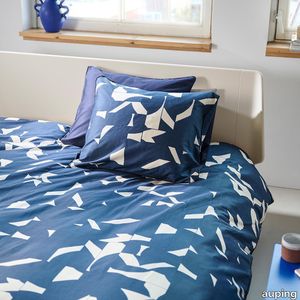
auping > Accessories
Dark blue duvet cover adorned with cream white origami shapes with a nod to the classic patchwork style. Fine dark lines elegantly frame the individual patterns. The piping on the pillowcases is a deep, dark blue that matches the colour on the reverse side of the pillowcase. These night colours create... Extra long tuck-in strip All Auping duvet covers have an extra long tuck-in strip across the entire width and on both sides. This makes it easy to tuck the duvet cover under your mattress. Cold feet are a thing of the past. You can recognize the extra long tuck-in strip by the length: 200/220. Pillowcase with double hotel closure The Auping pillowcases from the seasonal collection have a so-called double hotel closure. A hotel closure is a folded opening on the shortest side of the pillowcase. With a double hotel closure, it doesn't matter which side of your pillow you use, it always looks neat. Button down Auping duvet covers and duvets feature the button down system. These are convenient buttons and loops that you use to fasten the duvet and cover together so it won't shift. The term button down comes from fashion. It literally means "buttoned down" and often refers to the buttons on the collar of a shirt that you use to neatly fasten the collar to the shirt. Auping duvet covers have loops on the inside of the cover. Our duvets have buttons in the same places. The loops from the duvet cover can be put around these buttons so the duvet can't move around in the cover. And with these buttons and loops it is also easier to make your bed neatly. Sustainable sleeping At Auping, we dream of a rested world. Of sleeping under wonderful bedding that is made in an environmentally friendly way and under good working conditions. The covers in our spring 2023 collection carry the OEKO-TEX label as well as the BCI label, which also guarantees bedding produced in a sustainable and socially responsible manner.
Torii "Dining"
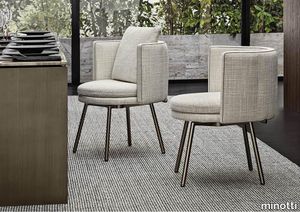
minotti > Chair
Airy, with constructive details linked to Japanese tradition, the Torii modular seats play with round edged volumes, thin profiles and the apparent formal simplicity of an extremely detailed design. The metal structure of the legs of the seats and tables is Nendo’s nod to the image of the “torii”, the entrance gate to Shinto shrines in Japan. With an interlocking game, the horizontal elements are laid on the vertical supports, ensuring a sophisticated visual lightness that accommodates the padded volume, characterised by couture craftsmanship. The Torii family includes sofas - with high or low backrest and a linear shape, rounded at the arms - inclined sofas with a combination of two different depths, armchairs and lounge and dining little armchairs, ottomans, coffee tables, and a slender, oval-shaped console table, ideal for placing anywhere in the living area. The varied range of products makes it possible to design a flexible layout, in which the individual elements can also be combined to create a strong visual unity. The metal frame found in the components of the Torii family evokes the image of the “Senbon Torii, the wooden colonnade that forms a gallery made up of 1,000 vermilion torii gates”, as Nendo reminds us. The slim backrest features vertical quilting and a piping running along the perimeter of the cushioning, underlining the couture quality of the craftsmanship. The eco-leather and eco-nubuck piping is in a slightly contrasting colour, but in the same shade as the fabric, if combined with a textile covering, whereas the leather versions come in the same shade when combined with leather upholstery. All the upholstered elements of the system can be customised by choosing the covering: 100% fabric or leather, or in fabric with a leather base. The seats can be accessorised with leather magazine caddy, crafted with fine luggage-crafting techniques and enriched with the same metal details as the base. The end of the horizontal metal element of the legs is designed so that it almost holds the backrest and seat, recalling the Kigumi technique, borrowed from the Japanese tradition of wood construction. A small decorative disk with Black-Nickel finish, in the form of a jewel-like button located at the end, adds a precious detail to the ensemble, and creates a series of contrasts with the Bronze colour varnished metal finish of the legs. The armchairs and swivel armchairs in the form of a perfect circle were designed to meet a variety of requirements, both in terms of functionality and ergonomics, available in a range of different types. The seats - in the Bergère, Large, Medium and Small versions - and the Dining, Dining Large and Lounge little armchairs are the result of the in-depth research carried out to find the best way to express the sophisticated simplicity of the craftsmanship. The base is available in leather or fabric. The extension of the base of some elements features a top in Calacatta or Stone Grey marble with a matt polyester lacquer finish, crafted with a careful study of its proportions, thickness and structural details so that it blends seamlessly into the seat, also from an aesthetic point of view. The Small armchair is also available in the Torii Nest version with braided leather backrest and a pattern inspired by Vienna straw, inserted in a solid ash wood frame that sits on a base in the same material. The Torii coffee tables also feature the same structural style details as the seats, reflected in the metal frame with Bronze colour varnished finish and details in Black-Nickel metal. Available in different sizes, ranging up to an impressive diameter of 120 cm, and different heights, they feature a top in Calacatta or Stone Grey marble with matt polyester finish, in Black pâte de verre or in Liquorice colour brushed ash wood, enclosed by a Liquorice colour matt lacquered frame.
Compatta Pisé Ghiaia

florim > Wall tile-stone-brick
<p>A passion for earth as a natural material and for rammed earth, an ancient construction technique.</p> <p>The combination of these patterns evolves into the concept of Pisé Inserti, more slabs of immense decorative impact, generated by the two-dimensional criss-crossing of exquisite, rounded geometrical forms: the designer combines the natural earthen shades with apparently random curved lines that evoke the uneven trapezia with rounded corners used by Gio Ponti.</p> <p>These are also available in the large 120x280 cm size and 6 mm thickness in three variants: Pisé Inserti A, Pisé Inserti B and Pisé Inserti C. COMPATTA’s potential is further enhanced by three-dimensional subjects of varying shapes, which can be built up into mesh-backed mosaics to create sculptural forms on walls. These extensions to the collection are called Inserti Melange, Inserti Sabbia-Argilla and Inserti Limo-Ghiaia and are produced in 9 mm thickness and 30x30 cm size.</p> <p>The collection is born from a sustainable and virtuous approach and is part of <a href="https://www.florim.com/en/company/sustainability/carbonzero-florim/">CarbonZero</a>, Florim's range of Carbon Neutral surfaces.</p> <p>The COMPATTA collection, designed by Federico Peri, combines a passion for earth as a natural material and an interest in a very ancient construction technique.<br>The primary inspiration derives from close observation of the many strata within the ground and the mixtures of elementary particles of which it consists. The design concept is completed by reference to the age-old rammed earth construction technique, used in northern Jordan since the eighth millennium BCE and widely applied in Yemen in many other desert or rural settings until the mid 19thC.<br>In this method, the raw earth is compacted inside wooden formwork to construct continuous structural walls, bearing walls or partitions inside homes, with a natural decorative effect due to the layering of the different shades of clay used. When creating his project for CEDIT, Peri was also influenced by several design inputs: from rural African homes to the clear, simple geometric forms and curved lines typical of the work of Gio Ponti, the curves central to the modernist gardens of Brazilian landscape artist Roberto Burle Marx, and the three-dimensional mosaics of English sculptor William Mitchell. In his murals in concrete, glass and recycled materials, Mitchell seems to combine some of the typical features of a variety of artistic movements, from Modernism to Brutalism, and also shows awareness of the issues concerning the structure of the landscape and the relationship with nature at the heart of Land Art. COMPATTA thus embodies strong links to the world of art and architecture, while bringing natural impressions with a remote, primitive flavour into modern living-spaces.</p>
Compatta Pisé Sabbia

florim > Wall tile-stone-brick
<p>A passion for earth as a natural material and for rammed earth, an ancient construction technique.</p> <p>The combination of these patterns evolves into the concept of Pisé Inserti, more slabs of immense decorative impact, generated by the two-dimensional criss-crossing of exquisite, rounded geometrical forms: the designer combines the natural earthen shades with apparently random curved lines that evoke the uneven trapezia with rounded corners used by Gio Ponti.</p> <p>These are also available in the large 120x280 cm size and 6 mm thickness in three variants: Pisé Inserti A, Pisé Inserti B and Pisé Inserti C. COMPATTA’s potential is further enhanced by three-dimensional subjects of varying shapes, which can be built up into mesh-backed mosaics to create sculptural forms on walls. These extensions to the collection are called Inserti Melange, Inserti Sabbia-Argilla and Inserti Limo-Ghiaia and are produced in 9 mm thickness and 30x30 cm size.</p> <p>The collection is born from a sustainable and virtuous approach and is part of <a href="https://www.florim.com/en/company/sustainability/carbonzero-florim/">CarbonZero</a>, Florim's range of Carbon Neutral surfaces.</p> <p>The COMPATTA collection, designed by Federico Peri, combines a passion for earth as a natural material and an interest in a very ancient construction technique.<br>The primary inspiration derives from close observation of the many strata within the ground and the mixtures of elementary particles of which it consists. The design concept is completed by reference to the age-old rammed earth construction technique, used in northern Jordan since the eighth millennium BCE and widely applied in Yemen in many other desert or rural settings until the mid 19thC.<br>In this method, the raw earth is compacted inside wooden formwork to construct continuous structural walls, bearing walls or partitions inside homes, with a natural decorative effect due to the layering of the different shades of clay used. When creating his project for CEDIT, Peri was also influenced by several design inputs: from rural African homes to the clear, simple geometric forms and curved lines typical of the work of Gio Ponti, the curves central to the modernist gardens of Brazilian landscape artist Roberto Burle Marx, and the three-dimensional mosaics of English sculptor William Mitchell. In his murals in concrete, glass and recycled materials, Mitchell seems to combine some of the typical features of a variety of artistic movements, from Modernism to Brutalism, and also shows awareness of the issues concerning the structure of the landscape and the relationship with nature at the heart of Land Art. COMPATTA thus embodies strong links to the world of art and architecture, while bringing natural impressions with a remote, primitive flavour into modern living-spaces.</p>
Compatta Sabbia

florim > Wall tile-stone-brick
<p>A passion for earth as a natural material and for rammed earth, an ancient construction technique.</p> <p>The combination of these patterns evolves into the concept of Pisé Inserti, more slabs of immense decorative impact, generated by the two-dimensional criss-crossing of exquisite, rounded geometrical forms: the designer combines the natural earthen shades with apparently random curved lines that evoke the uneven trapezia with rounded corners used by Gio Ponti.</p> <p>These are also available in the large 120x280 cm size and 6 mm thickness in three variants: Pisé Inserti A, Pisé Inserti B and Pisé Inserti C. COMPATTA’s potential is further enhanced by three-dimensional subjects of varying shapes, which can be built up into mesh-backed mosaics to create sculptural forms on walls. These extensions to the collection are called Inserti Melange, Inserti Sabbia-Argilla and Inserti Limo-Ghiaia and are produced in 9 mm thickness and 30x30 cm size.</p> <p>The collection is born from a sustainable and virtuous approach and is part of <a href="https://www.florim.com/en/company/sustainability/carbonzero-florim/">CarbonZero</a>, Florim's range of Carbon Neutral surfaces.</p> <p>The COMPATTA collection, designed by Federico Peri, combines a passion for earth as a natural material and an interest in a very ancient construction technique.<br>The primary inspiration derives from close observation of the many strata within the ground and the mixtures of elementary particles of which it consists. The design concept is completed by reference to the age-old rammed earth construction technique, used in northern Jordan since the eighth millennium BCE and widely applied in Yemen in many other desert or rural settings until the mid 19thC.<br>In this method, the raw earth is compacted inside wooden formwork to construct continuous structural walls, bearing walls or partitions inside homes, with a natural decorative effect due to the layering of the different shades of clay used. When creating his project for CEDIT, Peri was also influenced by several design inputs: from rural African homes to the clear, simple geometric forms and curved lines typical of the work of Gio Ponti, the curves central to the modernist gardens of Brazilian landscape artist Roberto Burle Marx, and the three-dimensional mosaics of English sculptor William Mitchell. In his murals in concrete, glass and recycled materials, Mitchell seems to combine some of the typical features of a variety of artistic movements, from Modernism to Brutalism, and also shows awareness of the issues concerning the structure of the landscape and the relationship with nature at the heart of Land Art. COMPATTA thus embodies strong links to the world of art and architecture, while bringing natural impressions with a remote, primitive flavour into modern living-spaces.</p>
Storie Casale

florim > Wall Paint
The faded wall fresco, damp stains in plaster. «Technological innovation enables us to reproduce on large-sized ceramic materials all the effects of wear and stratification that normally only time is able to create.» Giorgia Zanellato & Daniele Bortotto Children stare at the walls of a farmhouse, wondering what the cracks are, and whether every mark is a path and every path is a story. They think that miniature beings live in the air pockets that have formed, and the detaching plaster is like an avalanche cascading from a glacier. They don't ask why the colours are as they are, because they just had to be like that. And every square centimetre becomes the first page of an adventure that restarts at every break in the pattern. Could this be why we say that both textures and plots have twists, and stories are woven? As even children know, walls are tales. Not only do they contain adventures, emotions, moments, loves and hates and record them on their surfaces; their uneven, active surfaces generate new imaginary worlds, in which one can literally get lost. The "Storie" collection by Giorgia Zanellato and Daniele Bortotto brings this metaphor to three-dimensional life by expressing the moods, loves and hates and moments that the walls and floors of old Italian homes conserve, and capturing them in a frozen instant. The theme of time and the changes wrought in matter by the passing seasons, weather and human action have always been a strong source of inspiration for architects: some have tried to freeze it, while others have used sleight of hand to embrace it while resisting its effects, and yet others have accelerated, anticipated, directed and re-created it.<br /> Zanellato and Bortotto do all these things at once, engaging in a duel with History with a capital H, in which it is never clear who is winning: design or object, man or nature, culture or time. And it is probably this unresolved tension which makes the "Storie" designs so universal and meaningful, so intimate and yet familiar. The floor is the only thing we can be certain that everyone entering our home will touch, and at the same time it is the most intimate part, the most steeped in private happenings. They talk about having your "feet firmly on the ground". This image stands for common sense, but also a recognition of how things are, how things work. The wall is a synecdoche, too: it is the part of the home that expresses an idea of solidity, the layering of time, the passage of lives. "Storie" gives form to this metaphor by drawing a line that links the most classical of taste to a sophisticated modernity of taste and style. The two designers did a great deal of background work for this project: old Italian homes, country villas, noble palazzos, farmhouses and old factors, which become an unlimited source of motifs, colours, textures and materials. But, perhaps unconsciously, literature also re-emerges from this survey of locations, with its blend of aestheticism and decadence, with echoes of Wilde and D'Annunzio, Ruskin and Huysmans. "Storie" would be the ideal backdrop for Des Esseintes, the dandy in "A Rebours". And in fact the collection clearly has strong theatrical connections, arising partly from its storytelling connotations but also from its scene-setting potential.<br /> It represents life, which we are, have been and wish to continue to be. And it is thrilling to realise that this vision comes from the youngest designers in CEDIT's new era, who have successfully taken a confident, cultured, astute, sidelong approach to the most ancient of topics, with a persuasive effect which appears, at least, to be not at all intimidated by the many stories, the type of product they are dealing with, the catalogue in which they are included, the designers who have gone before them or, naturally, the adventures that lie concealed in the historic dwellings they reproduce. The reference to Italy, on the other hand, is in perfect harmony with the work of the brand and its past and present designers: it is intrinsic to the perfection of the production process that underlies the collection, the relationship with the brand's tradition and its local roots, and the intelligent, strategic use of its innovations in the treatment of this complex material.Child's play? Yes, but with the integrity and ability to enchant unique to specific designs, capable of an immediacy of vision and feeling that makes them little novels written in cement.
Cielo Pendant
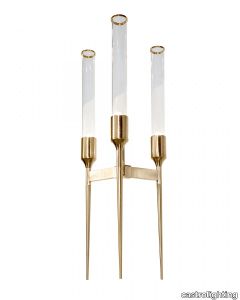
castrolighting > Ceiling lamp
Reveal the power of nature's majesty by inviting it inside your home with the Cielo Collection that has been inspired by nature's magnificence and its wonders - the fusion of pure elements. The Cielo Collection visualizes the concept of natural forces and their mysterious power. The fusion of pure elements – fire, ocean waves, sky, and stones – is the greatest source of inspiration. Fire creates delicacy, wave shapes stones, sky elevates magic, stone brings textures. Therefore, nature shapes lighting design. The Cielo Collection is the dynamic way of conceiving the world and the joy of discovery and wonder. The luxury oasis is waiting, imagine the calcite forms decorations that hang from the ceiling – stalactites with multi-coloured lighting that splits through rocks to glow in the dark. This time, Castro Lighting carries its manufacturing traditions transforming them into contemporary interior aesthetics – a minimal yet artistic expression of the modern lighting design within natural wonders. Brass finishes, textures, glass curves – the customization options are limitless. The Cielo Pendant lamp proudly bears the name which in Italian is related to sky or heaven. This handmade lighting fixture is made of gold-plated brass, the strong lines create an organic movement of subtle brass tubes complementing the luxury chandelier with clear glass. If you look closely enough, the extended tubes remind dangling stalactite and stalagmite shapes. Hammered by the hands of experienced craftsmen, it is capable of transforming the living space into grand adventurous scenery. This finest lighting design is a beautiful addition to complement the hotel lobby, large hallways, long staircases, or the spacious living room. The Cielo handcrafted gold pendant is the perfect choice for the interiors with modern classic style, contemporary vibes, as well as the art-deco touch. Feel the powerful energy of this pendant which brass elements complement the refinement of the interior and permit to reveal a new meaning of beauty. Simplicity, smooth texture, and clean glass lines help define this contemporary lighting design as the signature collection fitting to the most exquisite decors. VIEW FULL FAMILY
RAPA W - Stackable chair _ Zilio A&C
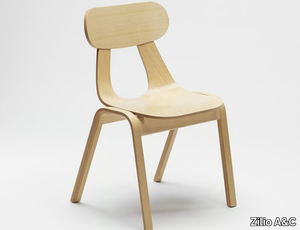
Zilio A&C > Chair
Rapa Wood Collection by Zilio A&C The Rapa Wood Collection by Zilio A&C exemplifies the fusion of minimalist design and functional versatility, offering seating solutions that seamlessly integrate into various interior settings. Crafted with precision and an eye for detail, this collection is a testament to Zilio A&C's commitment to quality and aesthetic appeal. Design and Aesthetic Designed by the renowned studio Mentsen, the Rapa Wood chair embodies a modern yet timeless aesthetic. Its clean lines and subtle curves make it a versatile piece suitable for diverse environments. The chair's minimalist design ensures it complements both contemporary and traditional interiors, adding a touch of elegance without overpowering the existing decor. Materials and Finishes The Rapa Wood chair is meticulously crafted from high-quality ash wood, known for its durability and attractive grain. The natural finish highlights the wood's inherent beauty, offering a warm and inviting appearance. This choice of material not only ensures longevity but also provides a sustainable option for environmentally conscious consumers. Dimensions and Specifications The chair measures 19.7 inches in length, 20.3 inches in depth, and 32 inches in height. These dimensions are thoughtfully designed to provide optimal comfort while maintaining a compact footprint, making it ideal for both spacious and limited areas. Versatility and Applications One of the standout features of the Rapa Wood chair is its stackability, allowing for efficient storage—a crucial aspect for commercial spaces like restaurants, cafes, and event venues. Its sleek design and comfortable seating also make it a perfect addition to residential dining areas, home offices, and collaborative workspaces. The chair's adaptability ensures it meets the demands of various settings without compromising on style or comfort. Alternative Options For those seeking variations in design, the Rapa collection also includes the Rapa Metal chair, which features a metal sled base, offering a different aesthetic while maintaining the collection's core design principles. Additionally, the Sciza range by Zilio A&C presents strong and versatile seating options made from solid beech, available in both chair and stool formats, with optional upholstered seats for enhanced comfort.
SPINE BIANCHE – WHITE THORNS
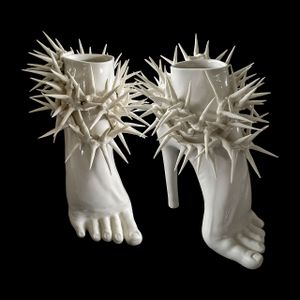
Elica Studio > Styling
SPINE BIANCHE – WHITE THORNS Material Porcelain, glaze Finishing Glossy Sizes (cm) 28 X 13 X 24 Weight (g) 1200 Designed in 2020 Collection Anatomika Lead Time: 30 days SPINE BIANCHE LUCIDE is a sculptural porcelain object that captures dramatic intensity through its spiky, crown-like silhouette. Its 30 cm height and broad base create a powerful presence, while the upward-flaring protrusions evoke natural forms—sea urchins, seed pods, or skeletal geometry—presented in a refined, abstracted way. The piece is coated in a high-gloss glaze that heightens its visual impact. Polished to a porcelain sheen, its surface reflects light like glass, emphasizing the rhythmic spikes and creating dynamic highlights. Subtle shifts in tone—from brilliant white peaks to gently darkened bases—are achieved through oxide washes, giving the work depth and visual richness. Shape & Concept Prominent, tapering central body crowned by sharp, irregular prongs Inspired by natural defence mechanisms, its form conveys resilience and tension The balance between smooth curves and jagged edges creates a sculptural dialogue of contrast Colour & Surface Glossy white glaze infuses the sculpture with elegance and modernity Oxide accents lend dimensionality without disturbing the minimalist palette Reflective finish brings energy and movement as light interacts with its peaks Styling Considerations Contemporary & Minimalist Interiors: Use as a focal art piece on a console or pedestal. The high-gloss finish stands out against matte, neutral backdrops. Industrial or Monochrome Environments: Complements raw materials like concrete or steel; adds a bold, organic note to clean, structural settings. Eclectic & Textural Schemes: Functions as a dramatic counterpoint to softer textiles, lush greenery, or wood tones. It draws attention while grounding the composition. Hospitality & Reception Areas: Its architectural form and strong visual identity make it ideal as an artistic assertion in foyers or lounge zones. Designer Highlights Visual Magnetism: Sculpture’s sharp silhouette captivates without fading into the background Material Drama: Glossy offers a modern sheen; oxides provide handmade authenticity Versatile Functionality: Scales well in both intimate and larger spaces Narrative Depth: The piece evokes natural metaphors—growth, protection, transformation—rich for storytelling in curated spaces Styling Tips Cast side or top lighting across the spines to create sculptural shadows and depth. Pair with muted tones—stone, linen, matte ceramics—for contrast and calm. Group with simpler forms of varying heights to balance the drama and soften visual intensity. In essence, SPINE BIANCHE LUCIDE is a sculptural anchor—a refined yet striking object that elevates interior design with textural contrast, organic drama, and polished elegance. It's a contemporary Arte Povera statement piece designed to intrigue and inspire.
OCC 22 c
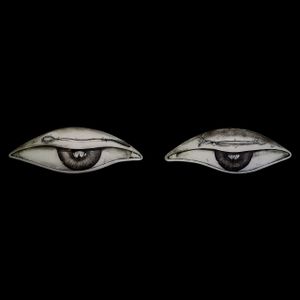
Elica Studio > Styling
OCC 22 c Material Porcelain, engobes, oxides, glaze Finishing Matte Sizes (cm) 38154 Weight (g) 900 Designed in 2022 Collection Anatomika Lead Time: 30 days OCC22 C is a sculptural porcelain artwork in the form of two symmetrical eyes, stylised in shape and illustrated with evocative precision. Each almond-shaped form cradles a hyper-detailed eye, half-veiled by what appears to be a scalpel or surgical instrument delicately resting across the upper lid. This interplay of vision and incision introduces a tension between seeing and cutting, observation and intervention. The porcelain surface is treated with a soft matte ivory glaze, lending the piece a skin-like quality. Over this base, hand-drawn black ink-style illustration renders the iris, lashes, and tool with remarkable intricacy—almost etching-like in its depth and texture. Despite the minimalist palette, the detailing animates the form with psychological intensity. OCC22 C is not decorative in the usual sense; it is narrative. It invites contemplation on vulnerability, perception, and the fine line between healing and harm. As a sculptural diptych, it is equally suited to wall display or flat presentation—an object of stillness and story. Styling & Placement Suggestions Art and Gallery Interiors: Position as a pair, eye-level, under soft spotlights. Their subtle symmetry and intense illustration make them perfect for spaces designed around visual storytelling and contemplation. Minimalist or Monochrome Rooms: These sculptural eyes punctuate clean lines with their quiet intensity. Pair with matte materials, black wood, or pale stone for harmony and contrast. Symbolic and Narrative Spaces: Ideal for meditation rooms, studios, or conceptual installations—where objects are chosen for their emotional and philosophical weight. Boutique and Creative Workspaces: Use OCC22 C to spark curiosity and reflection—especially in settings where design meets introspection. Why Designers Choose OCC22 C Conceptual Power: A strong metaphor—vision paired with precision—inviting reflection and narrative interpretation. Artisanal Illustration: Each line hand-applied with care, capturing fine anatomical and symbolic detail. Compact Statement: Small enough for shelves and niches, bold enough to anchor a vignette. Dual-Form Versatility: Can be placed as a symmetrical diptych or installed facing outward for dramatic tension. Styling Tip: Mount on matte black or dark walnut panels and illuminate from the top to reveal the etched textures. Leave space around them to enhance their psychological presence—they work best when isolated from visual noise. OCC22 C is a sculptural meditation in porcelain—vision rendered as both observer and subject. Ideal for interiors where design is personal, emotional, and deliberately unsettling. A piece to look at—and be looked back at.
ZOLLA
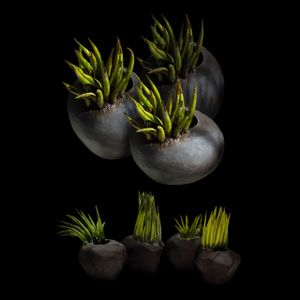
Elica Studio > Styling
Name: ZOLLA Material: Stoneware, engobes, oxides, glaze Finishing: Matte Sizes (cm): Approx. 27 (diameter/width) × 29 (height) Weight (g): ~2100 Designed in: 2013 Collection: Naturalia Lead Time: 30 days Description: The ZOLLA, an exceptionally innovative and deeply symbolic sculpture from Elica Studio's celebrated "Naturalia" collection, offers a profound connection to the elemental beauty of the earth and the vibrant emergence of life. Designed in 2013, this piece is a compelling statement for interior designers seeking to infuse spaces with organic authenticity, modern artistry, and a tactile sense of grounding. It embodies the captivating duality of robust earth meeting delicate growth, making it a unique and thought-provoking addition to high-end contemporary, biophilic, or minimalist design schemes. Masterfully crafted from durable stoneware, the ZOLLA boasts a rich, dark aesthetic, achieved through the expert application of engobes and oxides. The entire piece is treated with a sophisticated matte glaze, which absorbs light beautifully, highlighting its organic contours and textural qualities without harsh reflections. As vividly illustrated in the accompanying image, the ZOLLA takes the form of a rounded, somewhat irregular 'clod' or 'sod' of earth, appearing as a deep, muted charcoal or black. This base provides a solid, elemental foundation, evoking the raw beauty of soil or ancient rock formations. From the center of this dark, earthy mass, a cluster of vibrant, sharply pointed, green leaves or plant shoots vigorously emerges. The striking contrast between the dark, grounded base and the luminous, almost fluorescent green of the burgeoning foliage is the defining characteristic of the ZOLLA. The leaves, rendered with a dynamic, upward-reaching energy, symbolize growth, vitality, and the enduring power of nature to regenerate. This vibrant green is achieved through specialized glazes and oxides, ensuring its lasting brilliance. The interplay between the robust, matte stoneware and the lively, almost spiky green elements creates a captivating visual tension that is both aesthetically compelling and deeply symbolic of life bursting forth from the earth. The ensemble, often presented as a grouping in varying sizes, enhances the narrative of a thriving, natural landscape captured within an artful form. The ZOLLA, with its unique blend of organic form and contrasting elements, offers remarkable versatility for interior designers. It introduces a powerful, grounding presence in minimalist environments, adding intricate detail and a burst of natural color. In more eclectic or richly textured interiors, it acts as a distinctive anchor, harmonizing with diverse materials while asserting its unique artistic presence. Its strong connection to the "Naturalia" collection directly aligns with biophilic design principles, effortlessly bringing the tranquility and raw beauty of the natural world indoors. With dimensions of approximately 27 cm in diameter (or width) and 29 cm in height, and weighing a solid 2100 grams, the ZOLLA possesses a substantial yet approachable presence. Its versatile size makes it an ideal centerpiece for a coffee table, a captivating accent on a bookshelf or console, or as part of a curated grouping in a sophisticated lounge area or high-end commercial space. Designed in 2013, the ZOLLA continues to stand as a testament to enduring design and timeless appeal, proving its sustained relevance in contemporary interiors. For interior designers seeking to imbue their projects with unique character, a sense of authentic natural beauty, and a profound artistic sensibility, the ZOLLA is an unparalleled choice. Its intricate details, robust form, and symbolic depth position it as an investment piece that will resonate with clients who appreciate bespoke quality, sustainable materials, and a design that celebrates nature's inherent artistry. With a standard lead time of 30 days, incorporating this exceptional sculpture into project timelines is straightforward, promising to deliver a profound visual and textural experience that enhances the overall ambiance of any sophisticated interior.
NIGRUM

Elica Studio > Styling
Name: NIGRUM Material: Stoneware, engobes, oxides Finishing: Matte Sizes (cm): Approx. 45 × 45 × 40 (Height × Width × Depth) Weight (g): ~7500 Designed in: 2012 Collection: Naturalia Lead Time: 30 days Description: The NIGRUM, a profoundly enigmatic and powerfully sculptural object from Elica Studio's compelling "Naturalia" collection, offers an exploration into the darker, more abstract facets of organic life and natural decay. Designed in 2012, this piece is an extraordinary statement for interior designers seeking to introduce elements of raw artistic intensity, sophisticated mystery, and a unique biomorphic intrigue into their curated spaces. It embodies a fascinating dialogue between the resilience of form and the melancholic beauty of transformation, making it a compelling focal point in high-end contemporary, gothic-inspired, or avant-garde design schemes. Masterfully crafted from robust stoneware, the NIGRUM is characterized by its deep, uniform black aesthetic, achieved through the expert application of engobes and oxides. The entire piece is finished with a sophisticated matte surface, which absorbs light beautifully, emphasizing its complex textures and forms without harsh reflections. As vividly illustrated in the accompanying image, the NIGRUM presents as a substantial, spherical base, subtly speckled with lighter flecks that create an almost cosmic or weathered appearance, reminiscent of a celestial body or ancient stone. From this solid foundation, a dense array of intricate, branching structures vigorously emerges. These striking elements, also rendered in matte black, resemble an abstract forest of bare branches, coral formations, or perhaps the intricate root systems exposed from the earth. Their organic, almost gnarled quality adds a raw, untamed dimension to the piece. The interplay between the smooth, rounded base and the chaotic, dynamic branches creates a captivating visual and tactile contrast, inviting closer inspection. The monochrome black palette of the NIGRUM enhances its dramatic presence, allowing its extraordinary form and textural complexity to command full attention. Without the distraction of color, the viewer is drawn into the sculptural narrative, pondering its origins and symbolism. The NIGRUM, with its unique blend of organic abstraction and powerful visual impact, offers remarkable versatility for interior designers. It introduces a powerful, grounding presence in minimalist environments, providing intricate detail and a profound sense of artistic depth. In richly textured or eclectic interiors, it acts as a sophisticated anchor, harmonizing with diverse materials while asserting its unique, almost otherworldly presence. Its strong connection to the "Naturalia" collection is evident in its derivation from natural forms, albeit interpreted in a dark, sculptural, and highly abstract manner, creating a bridge between raw nature and refined art. Weighing a substantial 7500 grams and measuring approximately 45 cm in its various dimensions (height, width, depth), the NIGRUM possesses a commanding and weighty presence. Its robust nature and versatile size make it an ideal centerpiece for a substantial coffee table, a compelling accent on a large console in an entryway, or a curated addition to a sophisticated lounge area or high-end commercial space. Designed in 2012, the NIGRUM continues to stand as a testament to enduring design and timeless appeal, proving its sustained relevance in contemporary interiors. For interior designers seeking to imbue their projects with unique character, a sense of dark elegance, and a profound artistic sensibility, the NIGRUM is an unparalleled choice. Its intricate details, substantial form, and captivating visual impact position it as an investment piece that will resonate with clients who appreciate bespoke quality, enduring design, and a connection to the artistic exploration of nature's profound mysteries. With a standard lead time of 30 days, incorporating this exceptional sculpture into project timelines is straightforward, promising to deliver a profound visual and textural experience that enhances the overall ambiance of any sophisticated interior.
TURCOSA
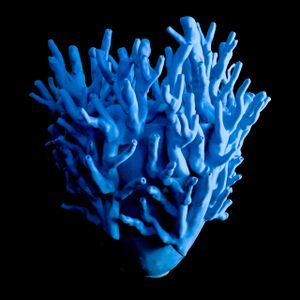
Elica Studio > Styling
Name: TURCOSA Material: Stoneware, engobes, oxides Finishing: Matte Sizes (cm): Approx. 25 × 25 × 32 (Height × Width × Depth) Weight (g): ~4500 Designed in: 2014 Collection: Naturalia Lead Time: 30 days Description: The TURCOSA, a truly mesmerizing and dynamically sculptural object from Elica Studio's compelling "Naturalia" collection, offers a vibrant deep dive into the enchanting forms of marine life, reimagined through a sophisticated artistic lens. Designed in 2014, this piece is an extraordinary statement for interior designers seeking to introduce elements of raw artistic intensity, serene oceanic beauty, and a unique biomorphic intrigue into their curated spaces. It embodies the captivating elegance of undersea ecosystems, making it a powerful and unique focal point in high-end contemporary, coastal-inspired, or avant-garde design schemes. Masterfully crafted from robust stoneware, the TURCOSA is characterized by its vivid, striking blue hue, achieved through the expert application of engobes and oxides. The entire piece is finished with a sophisticated matte surface, which absorbs light beautifully, highlighting its complex textures and organic forms without harsh reflections. As vividly illustrated in the accompanying image, the TURCOSA presents as a dense, intricate cluster of branching structures emerging from a more solid, organic base. These elements are sculpted with remarkable detail, mimicking the delicate yet resilient forms of branching coral or calcified marine growths. The vibrant turquoise-blue color is the defining characteristic of the TURCOSA, immediately drawing the eye and infusing the space with a sense of oceanic tranquility and depth. This specific hue evokes the crystal-clear waters of tropical seas, bringing a refreshing and invigorating palette to any interior. The branching, tubular forms create a captivating play of light and shadow, giving the piece a lively, almost pulsating quality. The matte finish ensures that despite its intense color, the sculpture retains an elegant, understated presence, allowing its intricate details and sculptural form to be fully appreciated. The TURCOSA, with its unique blend of organic abstraction and powerful visual impact, offers remarkable versatility for interior designers. It introduces a bold yet harmonious presence in minimalist environments, providing intricate detail and a profound sense of artistic depth. In richly textured or eclectic interiors, it acts as a vibrant anchor, harmonizing with diverse materials and colors while asserting its unique, almost otherworldly presence. Its strong connection to the "Naturalia" collection is evident in its derivation from natural forms, interpreted in a stunning, sculptural, and highly artistic manner, creating a seamless bridge between raw marine nature and refined art. Weighing a substantial 4500 grams and measuring approximately 25 cm in width, 25 cm in depth, and 32 cm in height, the TURCOSA possesses a commanding yet perfectly balanced presence. Its robust nature and versatile size make it an ideal centerpiece for a console table in an entryway, a compelling accent on a prominent bookshelf, or a curated addition to a sophisticated lounge area or high-end commercial space. Designed in 2014, the TURCOSA continues to stand as a testament to enduring design and timeless appeal, proving its sustained relevance in contemporary interiors. For interior designers seeking to imbue their projects with unique character, a sense of vibrant elegance, and a profound artistic sensibility, the TURCOSA is an unparalleled choice. Its intricate details, substantial form, and captivating visual impact position it as an investment piece that will resonate with clients who appreciate bespoke quality, enduring design, and a connection to the artistic exploration of nature's profound mysteries. With a standard lead time of 30 days, incorporating this exceptional sculpture into project timelines is straightforward, promising to deliver a profound visual and textural experience that enhances the overall ambiance of any sophisticated interior. Deep Research Canvas Gemini can make mistakes, including about people, so double-check it. Your p
SAL24 – SPINAE
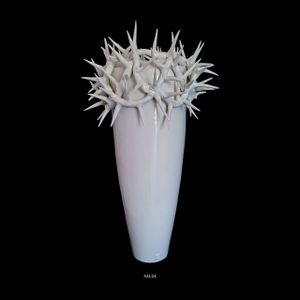
Elica Studio > Styling
Name: SAL24 – SPINAE Material: Porcelain, glaze Finishing: Glossy Sizes (cm): Approx. 38 (width) × 38 (depth) × 57 (height) Weight (g): ~3000 Designed in: 2024 Collection: Naturalia Lead Time: 30 days Description: The SAL24 – SPINAE vase, a strikingly bold and conceptually powerful piece from Elica Studio's renowned "Naturalia" collection, offers a dramatic artistic interpretation of nature's protective elements. Designed in 2024, this unique object transcends conventional decor, serving as a commanding sculptural statement that brings a sense of refined artistry, raw natural power, and contemporary avant-garde aesthetics to any interior. It is an ideal choice for interior designers seeking to infuse spaces with high-impact design, a connection to the wilder aspects of nature, and an undeniable artistic presence. Masterfully crafted from porcelain and finished with glaze, the SAL24 – SPINAE vase is characterized by its pristine white palette and captivating textural contrast. The entire piece boasts a luxurious glossy finish, which enhances its elegant, elongated silhouette and provides a luminous surface that beautifully reflects light, adding to its imposing presence. As vividly illustrated in the accompanying image, the vase features a tall, sleek, and slightly tapered body that rises gracefully from its base. What truly defines this creation is the breathtaking three-dimensional sculpting of numerous sharp, pointed spikes that form a formidable crown around its entire upper rim. Each spike is meticulously rendered, projecting outwards with an assertive, almost aggressive, beauty. These sculpted white spikes stand in stark contrast to the smooth, refined body of the vase, creating a powerful visual tension between elegance and untamed nature. The glossy finish on both the body and the spikes accentuates their forms, allowing light to play across their surfaces and highlight their intricate details. The design evokes imagery of thorny plants, porcupine quills, or even abstract geological formations, bringing a sense of primal energy and sophisticated danger into the domestic or commercial space. This piece is a testament to Elica Studio's ability to transform natural inspiration into a provocative and luxurious art form. The SAL24 – SPINAE vase, with its unique blend of natural motifs, bold sculptural form, and exquisite finish, offers remarkable versatility for interior designers. It can serve as a stunning standalone art piece, commanding attention on a grand console table, a credenza, or a prominent pedestal. While it could theoretically hold tall, slender flora, its inherent artistic merit allows it to function purely as a sculptural object, an art piece in its own right, delivering a strong visual statement. Its substantial weight of approximately 3000 grams and generous dimensions of approximately 38 cm in width and depth and 57 cm in height ensure an impressive and dominant presence in any luxury setting. Its aesthetic is particularly well-suited for adding a touch of sophisticated edge to minimalist interiors, enhancing a contemporary or industrial-chic space, or serving as a powerful focal point in an art-focused design scheme. Belonging to the "Naturalia" collection, it delves into the more formidable aspects of the natural world, interpreted through a lens of refined artistry. Designed in 2024, the SAL24 – SPINAE vase showcases Elica Studio's cutting-edge approach to ceramic art, ensuring its relevance and appeal in today's design landscape. For interior designers seeking to imbue their projects with unique character, a sense of avant-garde artistry, and a touch of engaging conceptual depth, the SAL24 – SPINAE vase is an unparalleled choice. Its distinctive aesthetic, thoughtful integration of form and powerful symbolism, and captivating visual impact position it as an investment piece that will resonate with clients who appreciate bespoke quality, enduring design, and a connection to the artistic exploration of nature's profound and multifaceted beauty. With a standard lead time of 30 days, incorporating this exceptional sculpture into project timelines is straightforward, promising to deliver a compelling visual experience that enhances the overall ambiance of any sophisticated interior.
Clarke Twin - Sofa Bed
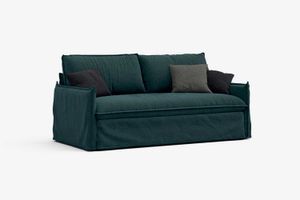
Milano Bedding > Sofa
CLARKE TWIN by Milano Bedding – Twin Armchair Bed for Compact Hospitality & Residential Spaces Name: Clarke Twin Material: Solid wood frame, multi-density polyurethane foam, steel mechanism Finishing: Removable crumpled-effect fabric upholstery, piped seams, matt black painted metal legs Sizes (cm): Width 120 | Depth 105 | Height 83 | Bed size 85×200 Weight: Approx. 90–100 kg Designed in: Italy Collection: Milano Bedding Sofa Beds Lead Time: 30 days 2D/3D Files: Available for download Compact, Comfortable and Full of Character The Clarke Twin by Milano Bedding is the perfect example of how functionality and relaxed style can coexist beautifully in a small footprint. Designed as a large armchair that opens into a real single bed, Clarke Twin is a smart choice for hotels, guest houses, student housing, serviced apartments, and compact residential interiors. With its iconic crumpled fabric look, soft edges, and generous seat, Clarke Twin brings a welcoming, informal elegance. The real surprise comes with the built-in Lampolet mechanism, which opens smoothly into an 85×200 cm bed with a 17 cm high mattress—ideal for regular sleep, not just emergency use. Materials, Fabrics & Finishing Details Built with a solid wood frame and supported by a strong steel base, Clarke Twin is designed for everyday performance. The seat and back cushions are made with polyurethane foam in differentiated densities, ensuring ergonomic comfort when sitting or sleeping. Its defining visual feature is the relaxed, slightly crumpled upholstery, available in Milano Bedding’s wide range of removable fabrics. From casual cottons to more refined, contract-grade textures, the selection allows designers to tailor Clarke Twin to a wide variety of schemes. The contrast piping adds a discreet tailored edge. The slim metal legs—in matt black—lift the silhouette off the floor, keeping it light and modern. Perfect Fit for Hospitality, Contract & Micro-Living Clarke Twin is a brilliant solution for: Hotel rooms and hostels requiring an extra single bed Student housing or micro-apartments where space is at a premium Short-stay rentals and Airbnb-style studios Home offices, reading corners, or guest rooms Design-led waiting areas or recovery rooms in clinics and spas Its compact size means it can fit where no full sofa bed can go—without compromising comfort or style. Visual Appeal & Styling Versatility The Clarke Twin combines relaxed softness with careful detailing. The laid-back fabric finish makes it feel cosy and familiar, while the piped seams introduce a sense of structure. Its deep seat and low arms invite lounging, making it a natural fit for Japandi, Scandinavian, or casual modern interiors. Pair it with textured throws or tonal cushions to elevate its styling, or let its relaxed form sit quietly in minimalist schemes. It works well on its own or grouped in larger lounge areas with its sibling models. Key Features & Configurations Opens into a single 85×200 cm bed Includes 17 cm thick polyurethane or memory foam mattress Upholstery is fully removable and washable Optional accessories include decorative cushions and linen bags Works as a stand-alone piece or as part of a broader Clarke series layout Explore the Clarke Family For a complete look or wider sleeping solutions, explore: Clarke Cross – Sofa bed version with a full double mattress Clarke Quilted – Same comfort with a neater, more structured look Vivien or Rufus – Alternatives for a more linear or compact aesthetic All Milano Bedding models include 2D and 3D files to simplify integration into your CAD drawings, renderings, and specifications. Clarke Twin is the ideal choice when you need a compact, designer armchair that secretly hides a full single bed—perfect for modern living with no compromise on aesthetics or comfort.
Vivien - Milano-Bedding
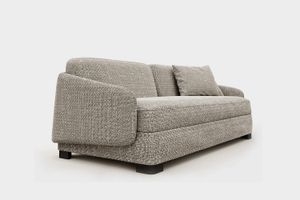
Milano Bedding > Sofa
VIVIEN by Milano Bedding – Feminine Elegance in a Sofa Bed with Hotel-Level Comfort Name: Vivien Material: Solid wood frame, polyurethane foam, steel Lampolet mechanism Finishing: Fixed or removable fabric or leather upholstery, painted metal legs Sizes (cm): Width 180–220 | Depth 100 | Height 82 | Bed size 140×200 or 160×200 Weight: Approx. 110–125 kg Designed in: Italy Collection: Milano Bedding Sofa Beds Lead Time: 30 days 2D/3D Files: Available for download Graceful Design with Smart Functionality The Vivien by Milano Bedding is a refined sofa bed that brings together softness, subtle curves, and a deeply feminine silhouette. Its compact proportions and elegant lines make it ideal for boutique hotels, luxury apartments, and residential guest rooms where style must meet performance. What sets Vivien apart is its gently curved armrests, slim frame, and tailored detailing—yet it houses a full 17 cm thick mattress inside. Thanks to the Lampolet mechanism, it converts effortlessly into a real bed, ideal for daily use, with no need to remove cushions. Build, Upholstery & Finishing Touches Vivien’s structure is made from solid wood, ensuring durability in contract environments. The cushions are crafted from high-resilience polyurethane foam, offering ergonomic support while maintaining a light, elegant appearance. It’s available in fixed or removable upholstery—including textured linens, soft velvets, wool blends, and smooth leathers. Choose soft pastel tones, creamy neutrals, or rich shades to adapt Vivien to your project’s atmosphere. Metal legs, finished in matt black or bronze, keep the look modern and minimal while adding lift and visual airiness. Perfect for Hospitality & Residential Projects Vivien is designed for spaces that need a compact, graceful sofa with true sleeping functionality, such as: Boutique hotel suites or high-end short-stay apartments Guest bedrooms or home libraries with dual use Luxury studio flats or co-living units Reception areas or VIP lounges where elegance is key Compact residential living rooms seeking sophistication and flexibility Its removable cover option makes it ideal for hospitality environments, where easy maintenance is essential. Style Direction and Interior Compatibility Vivien’s visual appeal lies in its curved armrests, slender back, and refined piping. The form is romantic but not ornate, and works well in Scandinavian, Japandi, or modern Parisian-style interiors. Styling options range from neutral and minimalist to warm and textural, depending on the selected fabric. It pairs beautifully with round coffee tables, layered rugs, and soft lighting—creating an inviting, boutique-hotel atmosphere. Specifications & Customisation Options Bed sizes: 140×200 cm or 160×200 cm Mattress height: 17 cm, available in polyurethane or memory foam Easy-to-open mechanism; no need to remove cushions Optional removable cover for convenience Matching scatter cushions and headrests available Explore Alternatives in the Collection If you love Vivien’s softness but are looking for different silhouettes, explore: Marsalis – Strong architectural lines and tailored feel Clarke Quilted – Relaxed with informal quilted upholstery Ellington – Classic proportions with compact form Jarreau – Bold volume and deep seat for high-impact design All products are available with 2D and 3D files, streamlining the specification process for interior designers and architects. Vivien by Milano Bedding is the ultimate blend of Italian elegance and smart functionality—a compact, luxurious sofa bed that brings lightness, charm, and true comfort to any space.
Tesori Broccato grigio
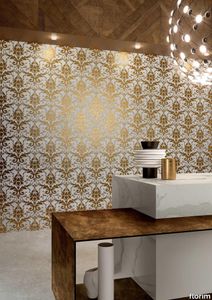
florim > Wallcovering
East and West, a synthesis archieved through Italian taste. «My work often takes me to far-off lands, also remote in terms of their culture and traditions. Even without my being aware of it, I then metabolise these traditions and include them in the designs I subsequently produce.» Matteo Nunziati <p>"It is the architect's task to create a warm, livable space. Carpets are warm and livable. He decides for this reason to spread one carpet on the floor and to hang up four to form the four walls. But you cannot build a house out of carpets. Both the carpet and the floor and the tapestry on the wall required structural frame to hold them in the correct place. To invent this frame is the architect's second task."When Adolf Loos wrote his revolutionary essay on the "principle of cladding" in 1898, architecture was just entering the modern age. Building meant imagining structures capable of putting together different materials, but, Loos affirmed, it must also respect their individual characteristics. "Every material possesses a formal language which belongs to it alone and no material can take on the forms proper to another", the Austrian master therefore maintained. And there is no doubt that the spirit of these words extended throughout most Twentieth Century architecture, regardless of its location or style. When we look at Matteo Nunziati's designs for the CEDIT Tesori collection, we seem to be seeing geometrical purity and attention to detail at the service of a new "truth" of material. Because Matteo Nunziati views ceramics as a form of fabric.<br /> The woven patterns he imagines for the various styles in his collection "“ from Arabian to damask to more geometrical motifs "“ constantly seek to provide the soft, iridescent look of time-worn linen. In them, ceramics are raised from the status of poor relation of marble to become a luxury wall covering in their own right: almost a wallpaper, suitable however for both floors and walls, and an absolutely versatile material. No longer only for beautifying bathrooms, they can create new moods in every room of the house (and elsewhere) starting from the living-room. Naturally, the revolution has been mainly technological. The large slabs produced by CEDIT are more than 3 metres tall, and since they eliminate the serial repetition typical of conventional tiles, they generate a new relationship between the surface and its decoration. However, Nunziati does not use this to create, artist-like, a more eye-catching decorative composition that emphasises the slab's dimensions. Quite the opposite; the patterns he offers us attempt to break down what is left of the boundaries between substrates. In particular, the Arabian and damask styles, in the version with "timeworn" patterning, convey the idea of the ceramic slab as an abstract, almost non-existent material which melts into the decorative motif applied to it, in a kind of pure wall covering.<br /> Through the patient selection of geometrical motifs and tests to verify their suitability for application to ceramic slabs, Nunziati aims to achieve a new material rather than a mere decoration, making this clear by also exploring its tactile dimension, with gouged and relief motifs. His "principle of coverings" therefore relates to ceramics' essence rather than their image: highlighting the versatility which, as we all know, has made ceramics an absolute material, a kind of cement that incorporates structure and finish in a virtually infinite range of applications. This is clearly indicated by the reference to the mashrabiya, a term meaning place where people drink in Arabic, which in Arabian architecture originally referred to the kind of veranda where people used to meet and rest, and over time has come to mean the wooden gratings that screened these places from the sun. Inspired by his trips to the Middle East, for Nunziati the geometric patterns of the mashrabiya become both an outline of his method of work and the form of what in fact becomes the key element in a new idea of space: a real location conceived around a strong, livable surface in which physical substance and decoration overlap to the point where they merge.</p>
Tesori Lino bianco

florim > Wallcovering
East and West, a synthesis archieved through Italian taste. «My work often takes me to far-off lands, also remote in terms of their culture and traditions. Even without my being aware of it, I then metabolise these traditions and include them in the designs I subsequently produce.» Matteo Nunziati <p>"It is the architect's task to create a warm, livable space. Carpets are warm and livable. He decides for this reason to spread one carpet on the floor and to hang up four to form the four walls. But you cannot build a house out of carpets. Both the carpet and the floor and the tapestry on the wall required structural frame to hold them in the correct place. To invent this frame is the architect's second task."When Adolf Loos wrote his revolutionary essay on the "principle of cladding" in 1898, architecture was just entering the modern age. Building meant imagining structures capable of putting together different materials, but, Loos affirmed, it must also respect their individual characteristics. "Every material possesses a formal language which belongs to it alone and no material can take on the forms proper to another", the Austrian master therefore maintained. And there is no doubt that the spirit of these words extended throughout most Twentieth Century architecture, regardless of its location or style. When we look at Matteo Nunziati's designs for the CEDIT Tesori collection, we seem to be seeing geometrical purity and attention to detail at the service of a new "truth" of material. Because Matteo Nunziati views ceramics as a form of fabric.<br /> The woven patterns he imagines for the various styles in his collection "“ from Arabian to damask to more geometrical motifs "“ constantly seek to provide the soft, iridescent look of time-worn linen. In them, ceramics are raised from the status of poor relation of marble to become a luxury wall covering in their own right: almost a wallpaper, suitable however for both floors and walls, and an absolutely versatile material. No longer only for beautifying bathrooms, they can create new moods in every room of the house (and elsewhere) starting from the living-room. Naturally, the revolution has been mainly technological. The large slabs produced by CEDIT are more than 3 metres tall, and since they eliminate the serial repetition typical of conventional tiles, they generate a new relationship between the surface and its decoration. However, Nunziati does not use this to create, artist-like, a more eye-catching decorative composition that emphasises the slab's dimensions. Quite the opposite; the patterns he offers us attempt to break down what is left of the boundaries between substrates. In particular, the Arabian and damask styles, in the version with "timeworn" patterning, convey the idea of the ceramic slab as an abstract, almost non-existent material which melts into the decorative motif applied to it, in a kind of pure wall covering.<br /> Through the patient selection of geometrical motifs and tests to verify their suitability for application to ceramic slabs, Nunziati aims to achieve a new material rather than a mere decoration, making this clear by also exploring its tactile dimension, with gouged and relief motifs. His "principle of coverings" therefore relates to ceramics' essence rather than their image: highlighting the versatility which, as we all know, has made ceramics an absolute material, a kind of cement that incorporates structure and finish in a virtually infinite range of applications. This is clearly indicated by the reference to the mashrabiya, a term meaning place where people drink in Arabic, which in Arabian architecture originally referred to the kind of veranda where people used to meet and rest, and over time has come to mean the wooden gratings that screened these places from the sun. Inspired by his trips to the Middle East, for Nunziati the geometric patterns of the mashrabiya become both an outline of his method of work and the form of what in fact becomes the key element in a new idea of space: a real location conceived around a strong, livable surface in which physical substance and decoration overlap to the point where they merge.</p>
Tesori Broccato bianco

florim > Wallcovering
East and West, a synthesis archieved through Italian taste. «My work often takes me to far-off lands, also remote in terms of their culture and traditions. Even without my being aware of it, I then metabolise these traditions and include them in the designs I subsequently produce.» Matteo Nunziati <p>"It is the architect's task to create a warm, livable space. Carpets are warm and livable. He decides for this reason to spread one carpet on the floor and to hang up four to form the four walls. But you cannot build a house out of carpets. Both the carpet and the floor and the tapestry on the wall required structural frame to hold them in the correct place. To invent this frame is the architect's second task."When Adolf Loos wrote his revolutionary essay on the "principle of cladding" in 1898, architecture was just entering the modern age. Building meant imagining structures capable of putting together different materials, but, Loos affirmed, it must also respect their individual characteristics. "Every material possesses a formal language which belongs to it alone and no material can take on the forms proper to another", the Austrian master therefore maintained. And there is no doubt that the spirit of these words extended throughout most Twentieth Century architecture, regardless of its location or style. When we look at Matteo Nunziati's designs for the CEDIT Tesori collection, we seem to be seeing geometrical purity and attention to detail at the service of a new "truth" of material. Because Matteo Nunziati views ceramics as a form of fabric.<br /> The woven patterns he imagines for the various styles in his collection "“ from Arabian to damask to more geometrical motifs "“ constantly seek to provide the soft, iridescent look of time-worn linen. In them, ceramics are raised from the status of poor relation of marble to become a luxury wall covering in their own right: almost a wallpaper, suitable however for both floors and walls, and an absolutely versatile material. No longer only for beautifying bathrooms, they can create new moods in every room of the house (and elsewhere) starting from the living-room. Naturally, the revolution has been mainly technological. The large slabs produced by CEDIT are more than 3 metres tall, and since they eliminate the serial repetition typical of conventional tiles, they generate a new relationship between the surface and its decoration. However, Nunziati does not use this to create, artist-like, a more eye-catching decorative composition that emphasises the slab's dimensions. Quite the opposite; the patterns he offers us attempt to break down what is left of the boundaries between substrates. In particular, the Arabian and damask styles, in the version with "timeworn" patterning, convey the idea of the ceramic slab as an abstract, almost non-existent material which melts into the decorative motif applied to it, in a kind of pure wall covering.<br /> Through the patient selection of geometrical motifs and tests to verify their suitability for application to ceramic slabs, Nunziati aims to achieve a new material rather than a mere decoration, making this clear by also exploring its tactile dimension, with gouged and relief motifs. His "principle of coverings" therefore relates to ceramics' essence rather than their image: highlighting the versatility which, as we all know, has made ceramics an absolute material, a kind of cement that incorporates structure and finish in a virtually infinite range of applications. This is clearly indicated by the reference to the mashrabiya, a term meaning place where people drink in Arabic, which in Arabian architecture originally referred to the kind of veranda where people used to meet and rest, and over time has come to mean the wooden gratings that screened these places from the sun. Inspired by his trips to the Middle East, for Nunziati the geometric patterns of the mashrabiya become both an outline of his method of work and the form of what in fact becomes the key element in a new idea of space: a real location conceived around a strong, livable surface in which physical substance and decoration overlap to the point where they merge.</p>